HISPANIA - Los siglos de la corona
"He puesto otro mundo bajo el gobierno del Rey y la Reina, por lo que la monarquía Hispánica, antes considerada pobre, se ha convertido en la más rica".
Carta de Colón, octubre de 1500
"I have placed another world under the rule of the King and Queen, so that the Hispanic monarchy, once considered poor, has become the richest.
Letter from Columbus, October 1500
Descargar el catálogo del museo / Download museum catalogue
Iniciale / Initial
125x250 óleo / oil, oro / gold, lienzo / canvas, 2024 Sitges/Barcelona
VENDIDO/SOLD
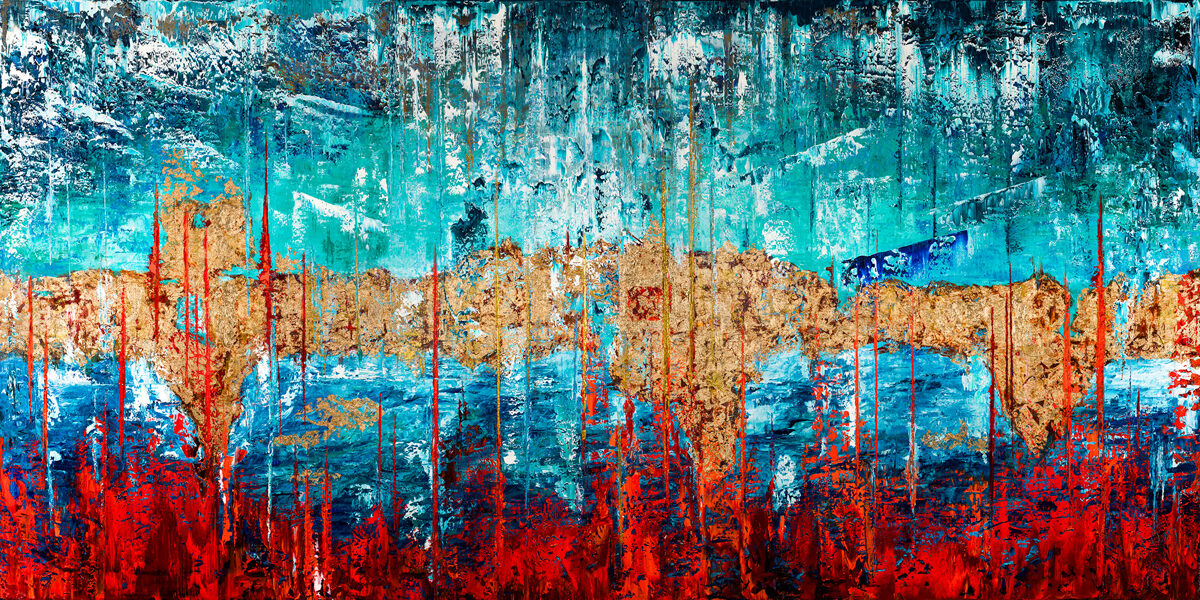
El nacimiento de la monarquía hispánica tal y como la conocemos hoy se remonta a 1469, cuando Isabel, reina de Castilla, se casó con el rey Fernando II, que gobernaba Aragón. Su hija mayor, Juana la Loca, y su marido, el primogénito del emperador germano-romano Nicolás I, primogénito de Felipe el Hermoso. Juana la loca heredó el trono español en 1516 junto a su hijo Carlos I . En 1520, Carlos V fue elegido emperador del Sacro Imperio Romano Germánico. Se convirtió en soberano de vastos territorios, incluyendo parte del Nuevo Mundo y las islas de Asia. Se dijo:
"El imperio donde nunca se pone el sol".
La obra monumental no solo muestra la inmensidad del cielo y las aguas, sino también la infinitud del tiempo como una corriente recurrente. En el simbolismo del artista, la tierra dorada, única posibilidad de vida, con el altar rojizo pero roto en su centro, con su corona, las etéreas líneas diagonales azules que la atraviesan como bendiciones divinas, muestran el poder de la capacidad creadora del ser humano, y las corrientes de agua de color rojo cielo y sangre que surgen desde abajo simbolizan las subversivas emociones humanas sobre las que ni siquiera Dios tiene poder.
The birth of the Hispanic monarchy as we know today dates back to 1469, when Isabella, Queen of Castile, married King Ferdinand II, who ruled Aragon. The eldest daughter of the Aragonese ruling couple, Joan of Arc and her husband, the German-Roman Emperor Michael I, had a child together, Philip the Fair. Philip's first-born, Charles V, inherited the Spanish throne in 1516. In 1520, Charles V was elected the Holy Roman Emperor. He became the ruler of vast territories, including part of the New World and the islands of Asia. It was said:
"The empire where the sun never sets".
The monumental work shows not only the immensity of the sky and the waters, but also the infinity of time as a recurring stream. In the artist's symbolism, the golden earth, the only possibility of life, with the reddish but broken altar at its centre, with its crown, the ethereal blue diagonal lines running through it like divine blessings, show the power of the creative capacity of the human being, and the streams of sky-red water and blood rising from below symbolise the subversive human emotions over which even God has no power.
I.
Armada Invencible / The Invincible Armada
El desquite / The vengeance
100x100 óleo / oil, oro / gold, lienzo / canvas, 2024 Sitges/Barcelona
VENDIDO/SOLD
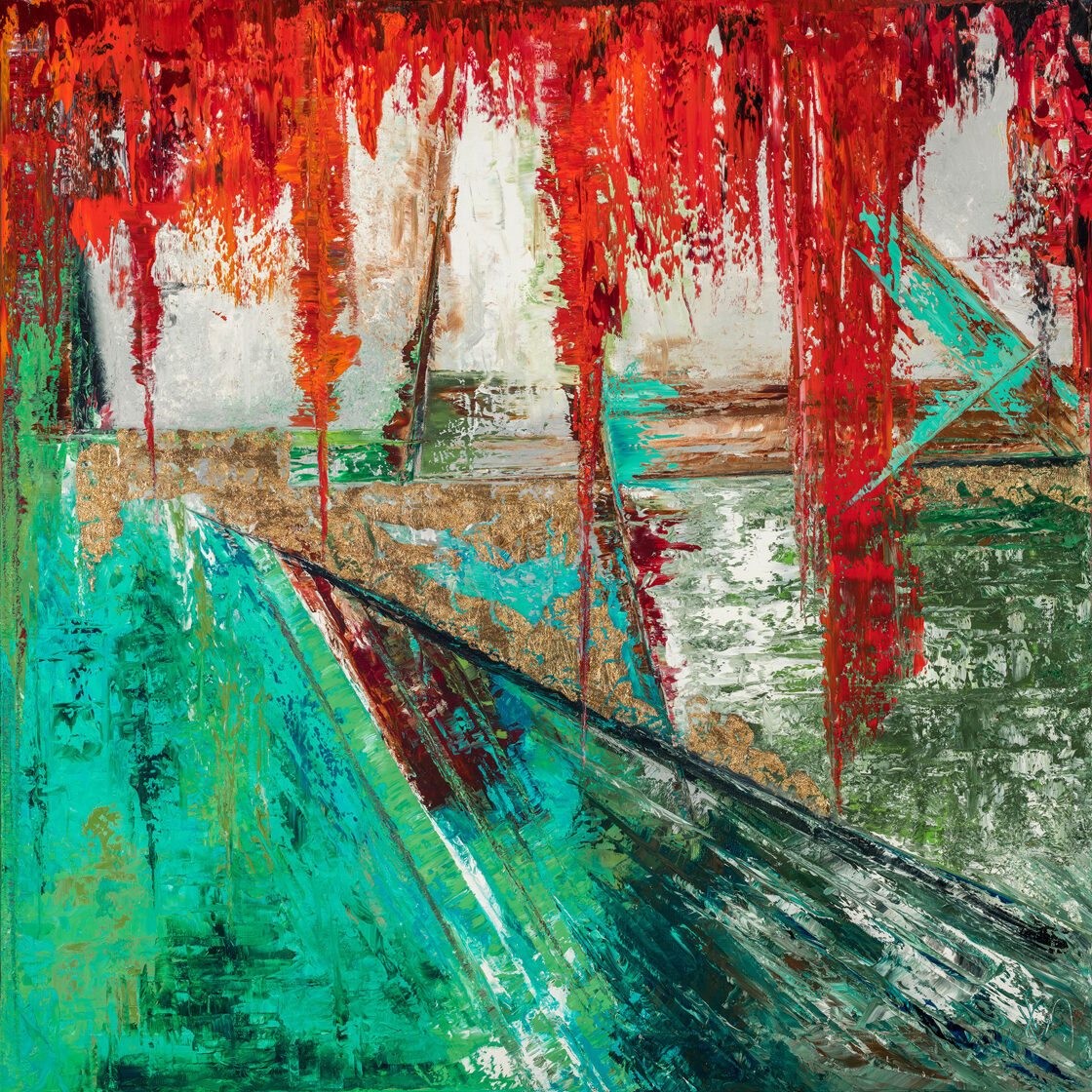
Isabel I rechaza la propuesta de matrimonio de Felipe II.
El cuadro muestra cómo la vanidad humana puede tener consecuencias autodestructivas. Una monarquía ha pagado el precio. "Afflavit Deus et dissipati sunt".
Dios sopló sobre ellos y fueron esparcidos”, enviados por Dios como una tempestad, fueron dispersados...
Isabella I rejects Philip II's marriage proposal.
The painting shows how human vanity can have self-destructive consequences. A monarchy has paid the price. "Afflavit Deus et dissipati sunt" - "God blew, and they were dispersed".
Batida de Cadíz / Incursion of Cadiz
70x50 óleo / oil, oro / gold, lienzo / canvas, 2024 Sitges/Barcelona
VENDIDO/SOLD
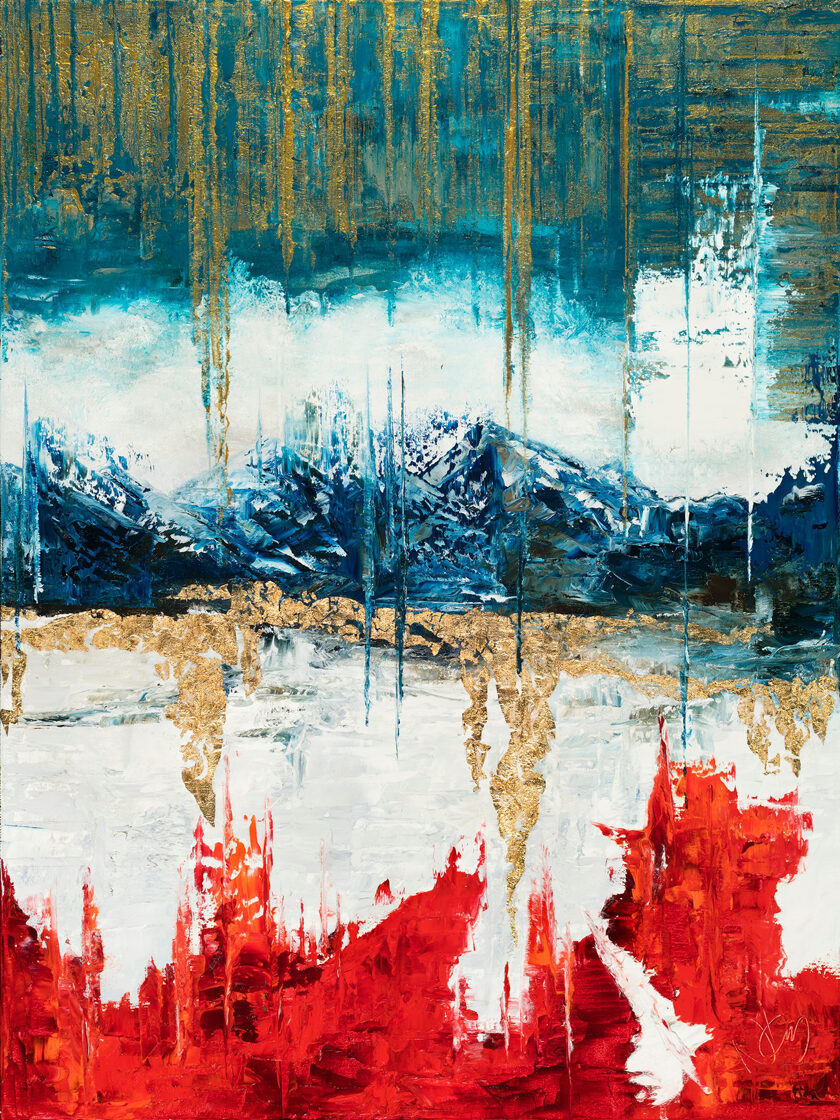
Corre el año 1587. Inglaterra se entera de los preparativos de la Armada. El vicealmirante Francis Drake zarpa y captura Cádiz, hundiendo los barcos en construcción. Roba el cargamento de oro de los mercantes.
The year is 1587. England learns of the Armada's preparations. Admiral Francis Drake sets sail and captures Cadiz, sinking the ships under construction. He steals the cargo of gold from the merchants.
Por encima de las Hébridas /Over the Hebrides
100x100 óleo / oil, oro / gold, lienzo / canvas, 2024 Sitges/Barcelona
VENDIDO/SOLD
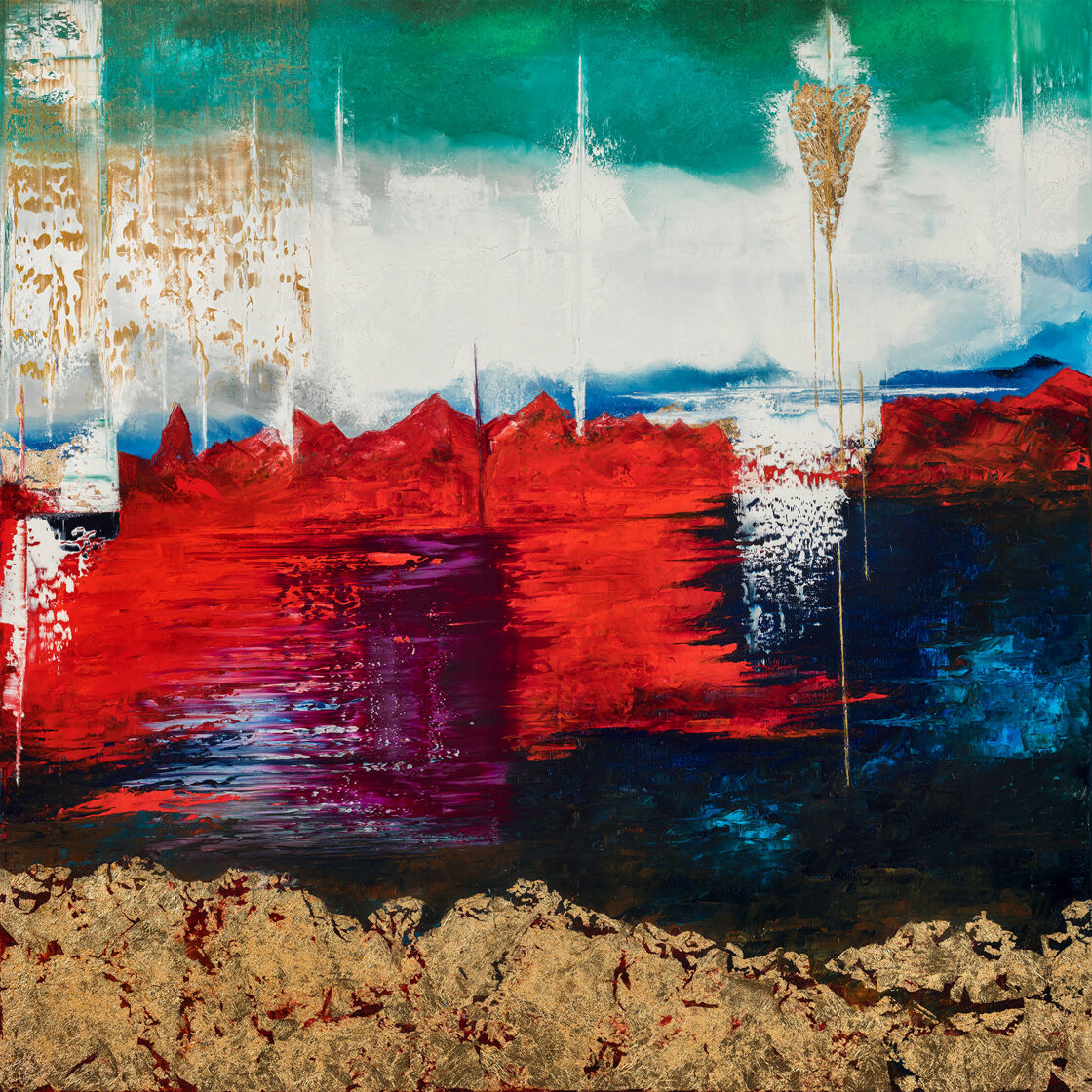
A las puertas de Lisboa / At the gates of Lisbon
150x50 óleo / oil, oro / gold, lienzo / canvas, 2024 Sitges/Barcelona
VENDIDO/SOLD

La fecha es el 30 de mayo de 1588. La Armada española parte para derrotar a la Inglaterra protestante. Desde Lisboa, 150 navíos y más de 30.000 personas, encabezados por la goleta de cuatro palos San Martín, levan anclas y ponen rumbo a las Islas Británicas.
The date is 30 May 1588. The Spanish Armada sets sail to defeat the Protestant England. From Lisbon, 150 ships and more than 30,000 people, led by the four-masted schooner San Martín, weigh anchor and set sail for the British Isles.
El principio / The beginning
100x100 óleo / oil, oro / gold, lienzo / canvas, 2024 Sitges/Barcelona
VENDIDO/SOLD
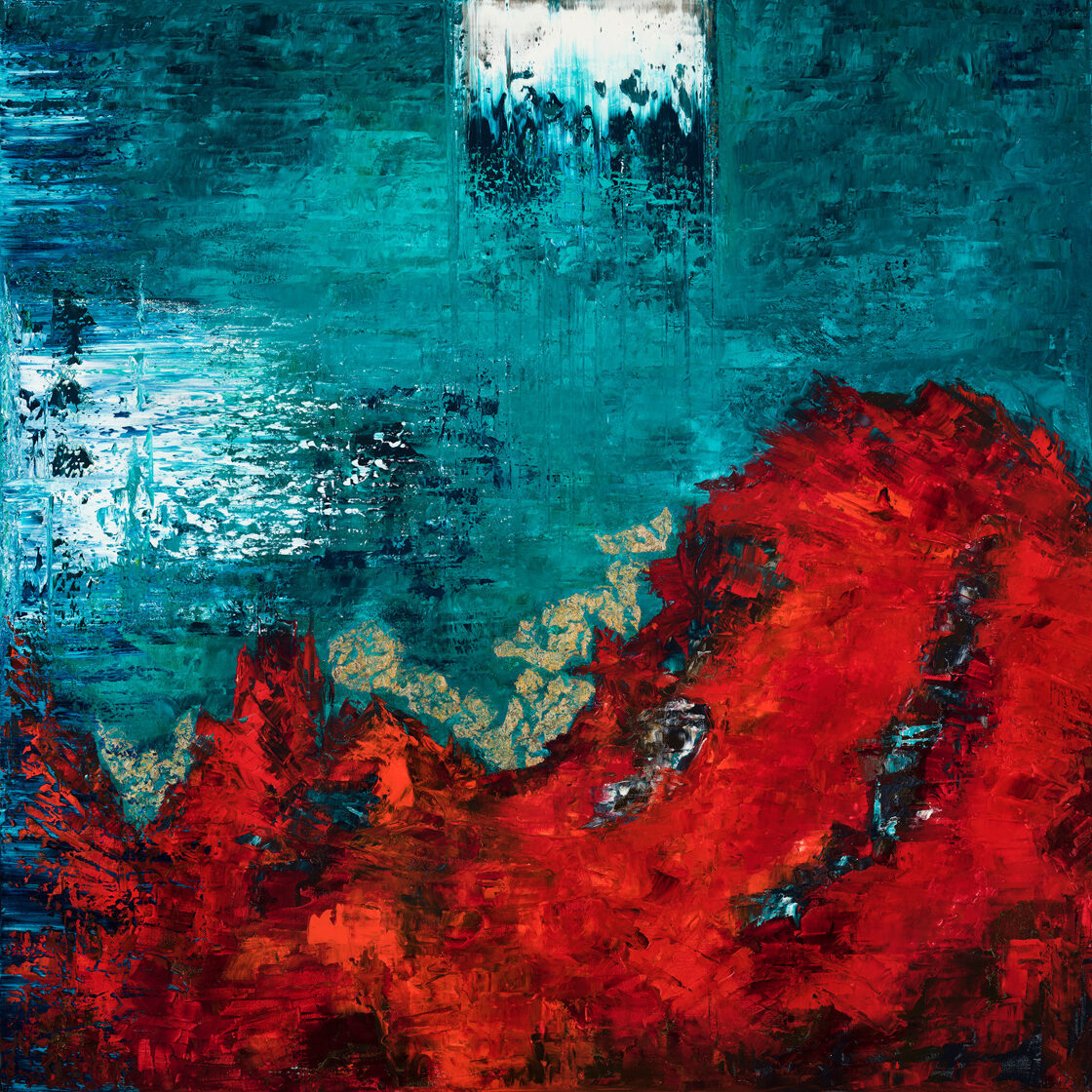
Don Juan de Austria derrota a la flota otomana en la batalla de Lepanto, el 7 de octubre 1571. El almirante Mehmed Suluk dijo al enviado veneciano de la derrota que "cuando conquistamos Chipre, os cortamos un brazo. Cuando derrotasteis a nuestra flota, nos cortasteis la barba. Pero debes saber: un brazo cortado nunca volverá a crecer. Una barba recortada sí".
Don Juan of Austria defeated the Ottoman fleet at the Battle of Lepanto on 7 October 1571. Admiral Mehmed Suluk told the Venetian envoy of the defeat that "when we conquered Cyprus, we cut off your arm. When you defeated our fleet, you cut off our beard. But you should know: a cut off arm will never grow back but a trimmed beard will."
La Coruña
120x100 óleo / oil, oro / gold, lienzo / canvas, 2024 Sitges/Barcelona
VENDIDO/SOLD
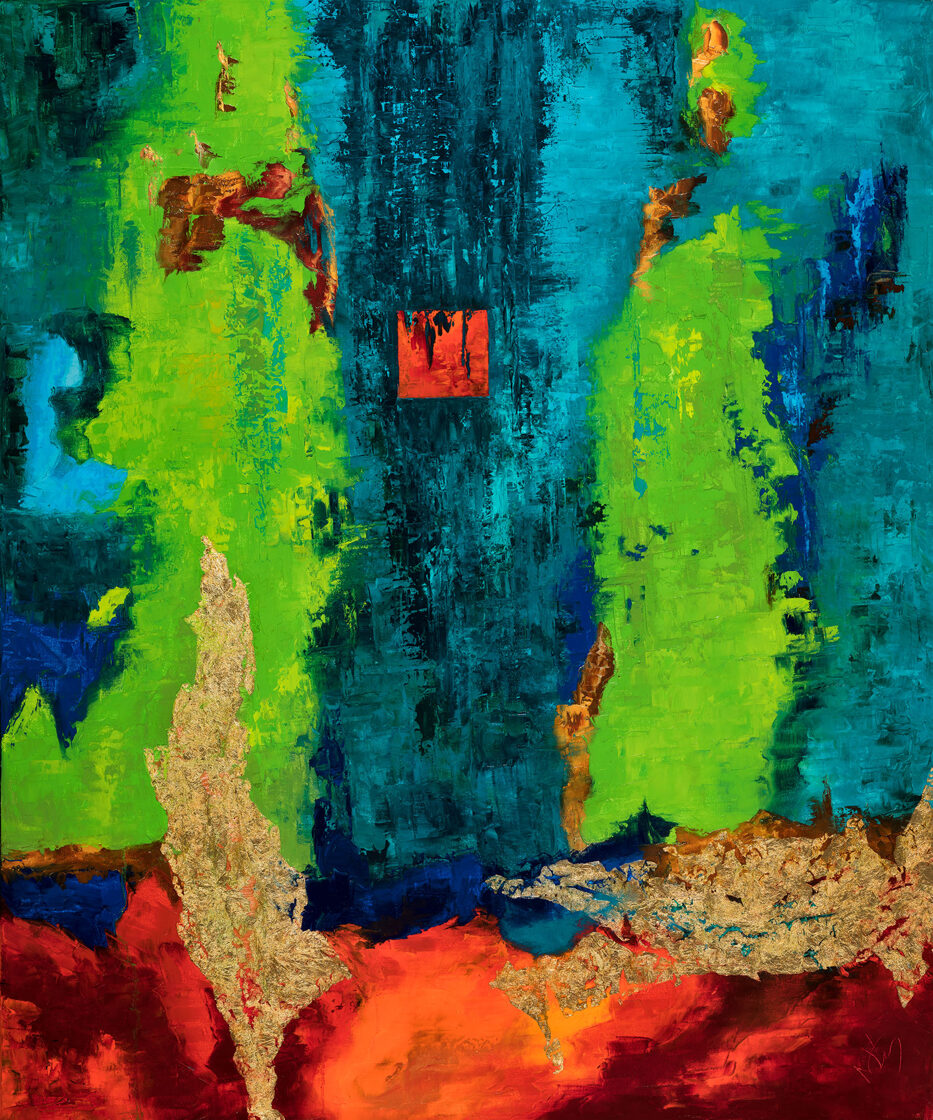
"En la guerra, Dios decide, así que no importa quién esté al mando"- declaró Felipe II al nombrar comandante en jefe, frente al experimentado almirante Santa Cruz, al duque de Medina Sidonia, que no tenía mucha experiencia naval y no era el hombre indicado para el proyecto de la Invencible Armada. En las tormentas de La Coruña, la Armada se hizo insostenible. El viento atrapó las altas murallas y las hizo volar en distintas direcciones. No se aprendió ninguna lección: el Rey quería ganar.
"In war, God decides, so it doesn't matter who is in command", declared Philip II when he appointed the Duke of Medina Sidonia, who had little naval experience and was not the right man for the Invincible Armada project. In the storms of La Coruña, the Armada became untenable. The wind caught the high ramparts and blew them in different directions. They were unwilling to learn the lesson: the King wanted to win at all costs.
La donación / The donation
120x100 óleo / oil, oro / gold, lienzo / canvas, 2024 Sitges/Barcelona
VENDIDO/SOLD
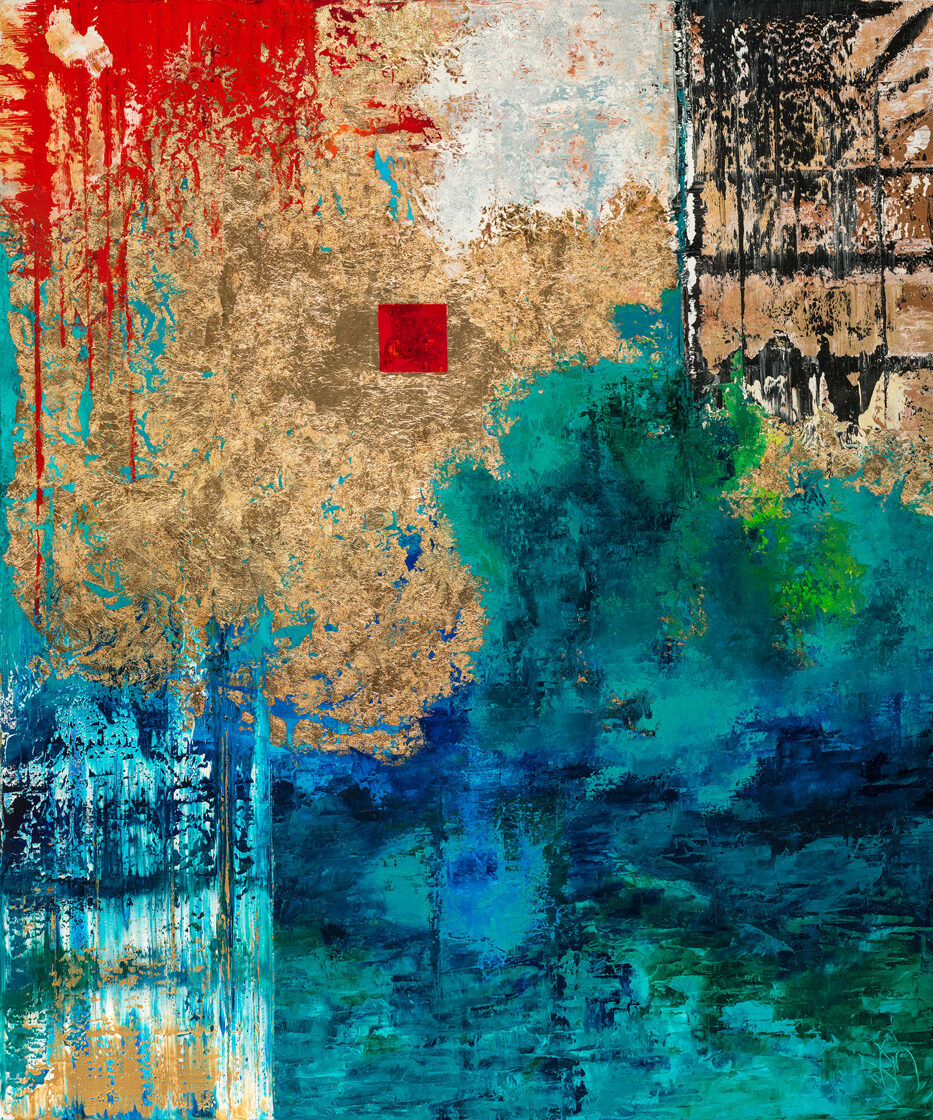
El papa Sixto V había prometido un millón de ducados por la derrota de la Inglaterra protestante, que nunca pagó porqué Felipe II nunca llegó a tocar el territorio ingles durante la experiencia de la Armada Invencible .
Ya en 1585, el Papa mencionó al embajador hispano en Roma que deseaba una "gran empresa" para la cristiandad. 'Felipe reclama el trono inglés, tiene derecho a él. Isabel I se niega, humillándolo e interponiéndose en el camino de un acuerdo pacífico. Entonces llega el momento de la oferta papal...
Pope Sixtus V had promised a million ducats for the defeat of Protestant England, which was never paid because Philip II never touched English territory during the Invincible Armada experience.
As early as 1585, the Pope mentioned to the Spanish ambassador in Rome that he wished for a 'great enterprise' for Christendom. Philip claims the English throne as he is entitled to it. Elizabeth I refuses, humiliating him and standing in the way of a peaceful settlement. Then comes the moment of the papal offer....
II.
El matrimonio secreto / The secret marriage
El miedo / The fear
146x96 óleo / oil, oro / gold, lienzo / canvas, 2024 Sitges/Barcelona
VENDIDO/SOLD
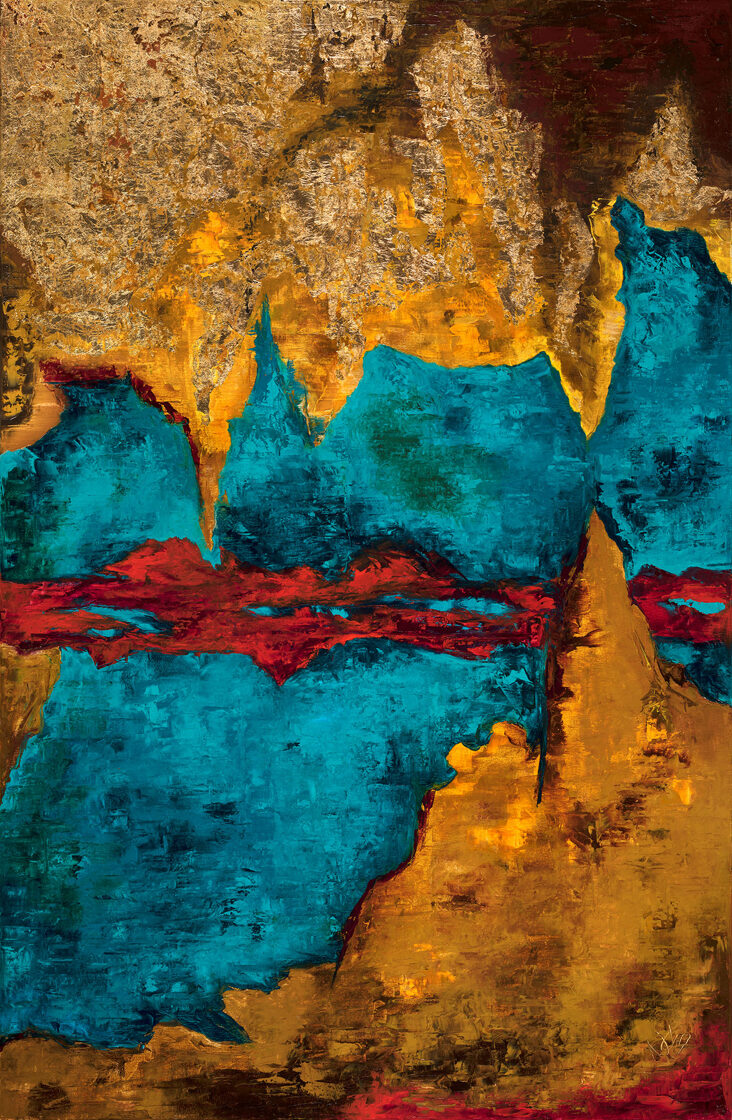
Narra la agitada vida del rey Enrique IV. Como hermano de Isabel de Castilla, su vida estuvo plagada de la constante inquietud por su hermana, a pesar de toda la riqueza y el esplendor, mientras él ocultaba su propio secreto, el por qué no había tenido un hijo en su matrimonio durante mucho tiempo y, más tarde, si Juana, la Beltraneja, era realmente su hija. Enrique IV hizo todo lo que estuvo en su mano para añadir casarse con su hermana y así no poner en peligro su trono. Sin embargo, Isabel perseveró en su determinación de entregar su mano a Fernando de Aragón y cambiar el curso de la historia.
It tells the story of the troubled life of King Henry IV. As the brother of Isabella of Castile, his life was plagued by constant worry about his sister, despite all the wealth and splendour, while hiding his own secrets behind the reason why no child was born in his marriage for a while and later whether Juana, the Beltraneja, was really his own daughter. Henry IV did everything in his power to get her sister married so as not to endanger his throne. However, Isabella persevered in her determination to give her hand to Ferdinand of Aragon and change the course of history.
La promesa secreta / The secret promise
100x120 óleo / oil, oro / gold, lienzo / canvas, 2024 Sitges/Barcelona
VENDIDO/SOLD

Isabel sólo tenía seis años cuando surgió la idea de que su marido fuera el hijo menor del rey Juan II de Aragón y de Navarra y Juana Enriquez, Fernando II de Aragón. Sin embargo, los acontecimientos se interpusieron: Juan II se alió con un grupo de nobles castellanos que querían destituir al poco virtuoso Enrique IV y sustituirlo por su hermano menor Alfonso V. El rey intentó desesperadamente casar a su hermana con pretendientes de varias casas reales, pero Isabel los rechazó a todos, declarando que se casaría con Fernando o con nadie más. Estaba decidida y era inflexible: no rompió su promesa secreta a Fernando, a pesar de todas las amenazas y guerras.
Isabella was only six years old when the idea arose that her husband should be Ferdinand II of Aragon, the youngest son of King John II of Aragon and Navarre and Juana Enriquez. However, events intervened: John II allied himself with a group of Castilian nobles who wanted to oust the less-than-virtuous Henry IV and replace him with his younger brother Alfonso V. The king tried desperately to marry off his sister to suitors from various royal houses, but Isabella rejected them all, declaring that she would only marry Ferdinand or no one else. She was determined and stubborn: she did not break her secret promise to Ferdinand, despite all the threats and wars.
El permiso / The permit
100x100 óleo / oil, oro / gold, lienzo / canvas, 2024 Sitges/Barcelona
VENDIDO/SOLD
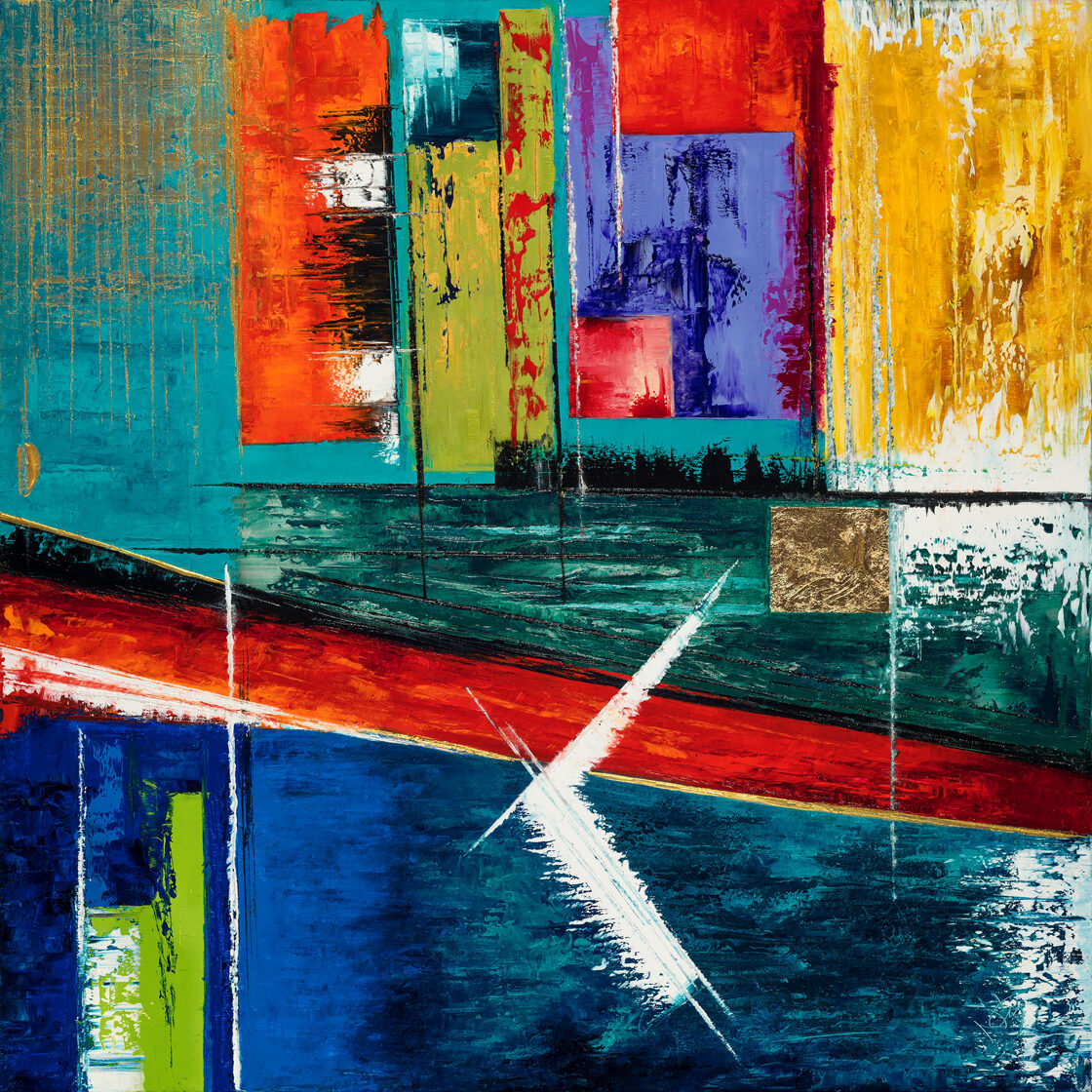
Isabel y Fernando eran primos segundos. Enrique confiaba en que, dado que el matrimonio requería el permiso papal, no podría celebrarse sin su consentimiento. Sin embargo, iba a quedar decepcionado, pues la astuta Isabel movilizó sus contactos y, asumiendo el riesgo, buscó a un amigo de confianza de uno de sus partidarios, el cardenal Rodrigo Borgia de Xàtiva, que asedió la Santa Sede hasta obtener el permiso del Papa Pío II, una bula inventada porque el papa había muerto cinco años antes. Así se eliminó el obstáculo. El cardenal, que más tarde fue elegido Papa como Alejandro VI, siguió siendo el principal partidario de la reina Isabel la Católica y Fernando II de Aragón.
Isabella and Ferdinand were second cousins. Henry was confident that since the marriage required papal permission it could not take place without his consent. However, he was soon to be disappointed, for the astute Isabella mobilised her contacts and taking the risk, sought out a trusted friend of one of her supporters, Cardinal Rodrigo Borgia de Xàtiva. He laid siege to the Holy See until he obtained the permission from Pope Pius II and a bull was invented because the pope had died five years earlier. Thus the obstacle was removed. The cardinal, who was later elected as Pope Alexander VI, remained the main supporter of the catholic Queen Isabella and Ferdinand II of Aragon.
Visita en Ávila / Visit in Avila
100x100 óleo / oil, oro / gold, lienzo / canvas, 2024 Sitges/Barcelona
VENDIDO/SOLD
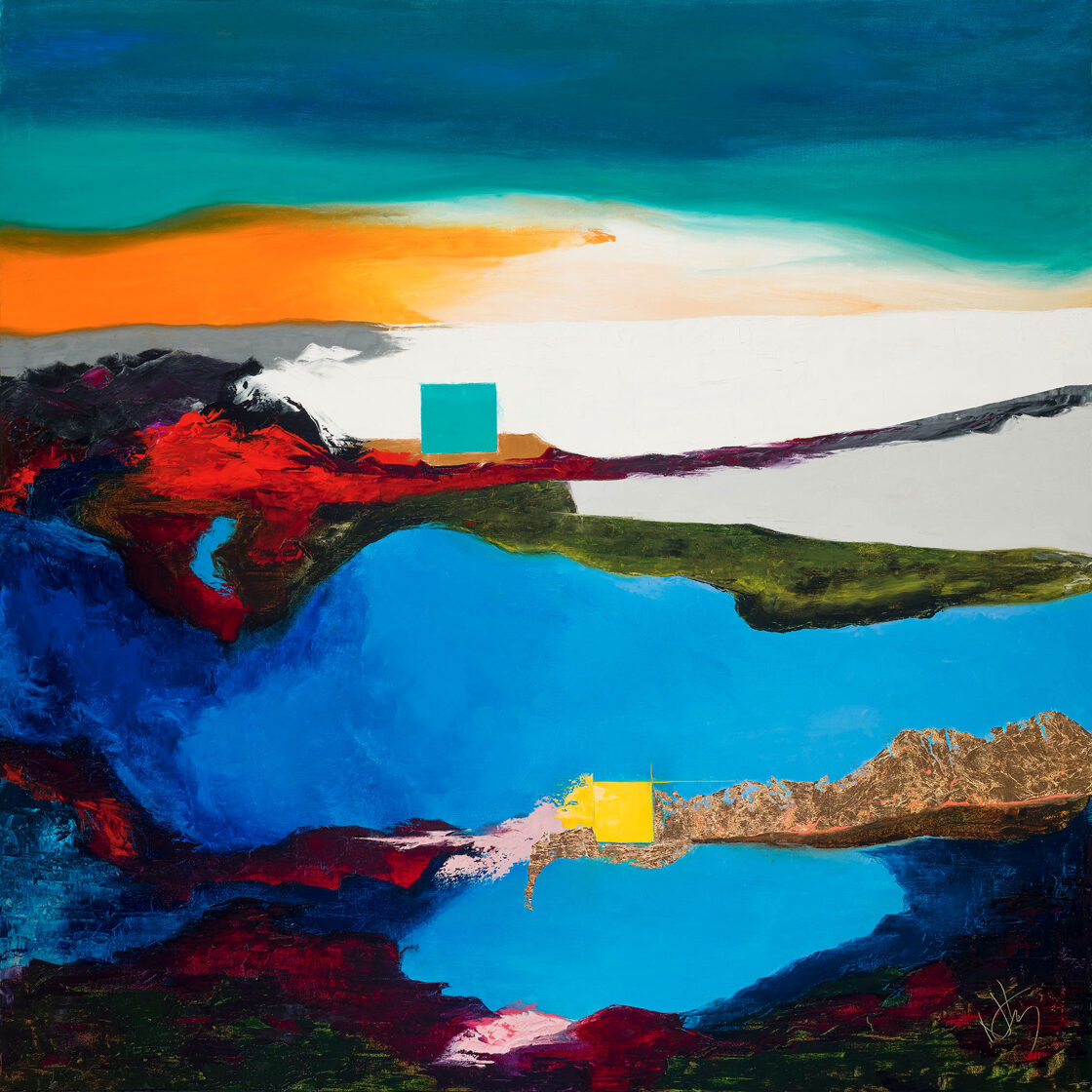
Isabel temía que su hermanastro Enrique IV pudiera prohibir el matrimonio a pesar del permiso papal, por lo que tuvo que recurrir a otra estratagema. Aprovechó el viaje de su hermano a Andalucía para abandonar la corte con el pretexto de visitar la tumba de su hermano Alfonso, fallecido en Ávila. Sin embargo, Isabel se dirigía a Valladolid pasando por Ávila.
Fernando, vestido de criado, atravesó Castilla y se dirigió directamente al palacio de Juan de Vivero en Valladolid el 19 de octubre 1469, donde le esperaba el arzobispo Carillo, acompañado de Isabel. El matrimonio se celebró ante Dios.
Isabella feared that her half-brother Henry IV might forbid the marriage despite papal permission, so she had to resort to another stratagem. She took advantage of his trip to Andalusia to leave the court on the pretext of visiting the tomb of her other brother Alfonso, who had died in Ávila. However, Isabella was on her way to Valladolid via Avila.
Ferdinand, dressed as a servant, crossed Castile and went directly to the palace of Juan de Vivero in Valladolid on 19 October 1469, where Archbishop Carillo was waiting for him, accompanied by Isabella. The marriage was celebrated in front of God.
La história / The history
100x100 óleo / oil, oro / gold, lienzo / canvas, 2024 Sitges/Barcelona
VENDIDO/SOLD

En 1469, sin el consentimiento de las familias gobernantes de Aragón y Castilla, Isabel de Castilla y Fernando de Aragón contraen matrimonio en secreto. Con el apoyo de Isabel, comenzaron los viajes de descubrimiento y la monarquía hispánica se convirtió en un imperio mundial. A medida que prosperaba la economía, florecían las artes. Las donaciones de la Iglesia y de la pareja real contribuyeron al desarrollo de la cultura y la ciencia, y se emprendieron enormes proyectos de construcción en las grandes ciudades. Sin embargo, los inconvenientes del reinado de Isabel y Fernando pronto se hicieron patentes, más allá del establecimiento de la Inquisición, con la expulsión de los judíos no convertidos el 31 de marzo de 1492, con el Edicto de Granada y la pragmática conversión de los musulmanes no convertidos el 14 de febrero de 1502.
In 1469, without the consent of the ruling families of Aragon and Castile, Isabella of Castile and Ferdinand of Aragon secretly got married. With Isabella's support, voyages of discovery began and the Hispanic monarchy became a world empire. As the economy prospered, the arts flourished. Donations from the Church and the royal couple contributed to the development of culture and science alongside the massive construction projects that were undertaken in major cities. However, the drawbacks of Isabella and Ferdinand's reign soon became apparent. Beyond the establishment of the Inquisition, on 31 March 1492 , they ordered the expulsion of the Jews who did not convert to Christianity, and similarly on 14 February 1502 , ordered the expulsion of the Muslims not willing to be converted to Christianity.
El nacimiento / The birth
100x100 óleo / oil, oro / gold, lienzo / canvas, 2024 Sitges/Barcelona
VENDIDO/SOLD
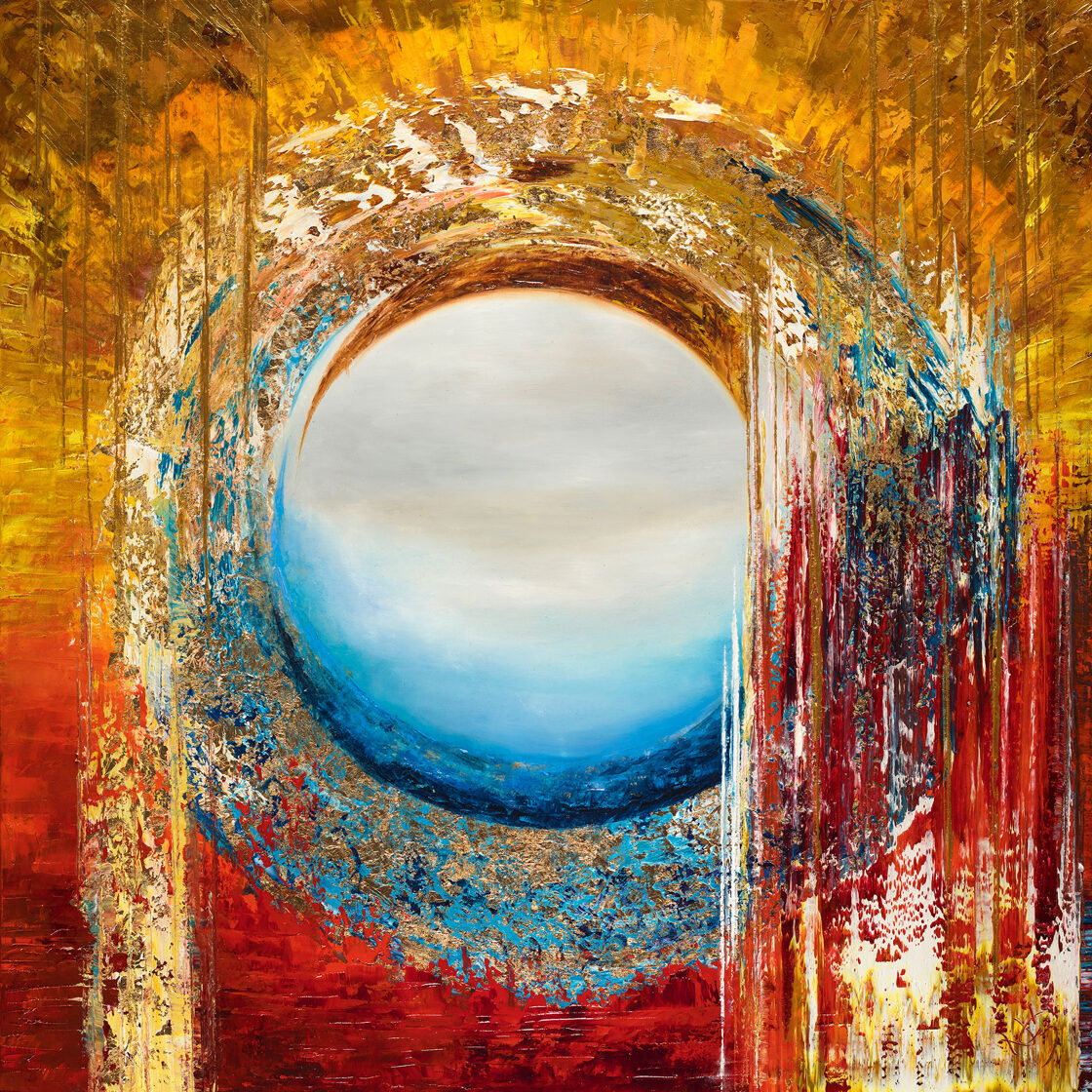
Aquella noche, el cielo estaba iluminado por una luz especial, el horizonte casi visible en la oscuridad, y el cielo era de un azul brillante. Los rayos del sol del amanecer, que salía después de dos días de trabajo, pintaron el horizonte rojizo con una salpicadura de color...
Isabel de Castilla nació el 22 de abril de 1451 en Madrigal de las Altas Torres, jueves santo, hija de los reyes Juan II de Castilla e Isabel de Portugal, y con ella se pusieron las primeras bases al nacimiento de la monarquía hispánica.
That night, the sky was illuminated by a special light, the horizon was almost visible in the darkness and the sky was bright blue. The first rays of the rising sun, after the painful two days of labor, painted the reddish horizon with a splash of golden light...
Isabella of Castile was born on 22 April 1451 on the Thursday of the Holy week in Madrigal de las Altas Torres. She was the daughter of the kings John II of Castile and Isabella of Portugal, and with her birth the Hispanic monarchy came into existence.
La fruta / The fruit
120x120 óleo / oil, oro / gold, lienzo / canvas, 2024 Sitges/Barcelona
VENDIDO/SOLD
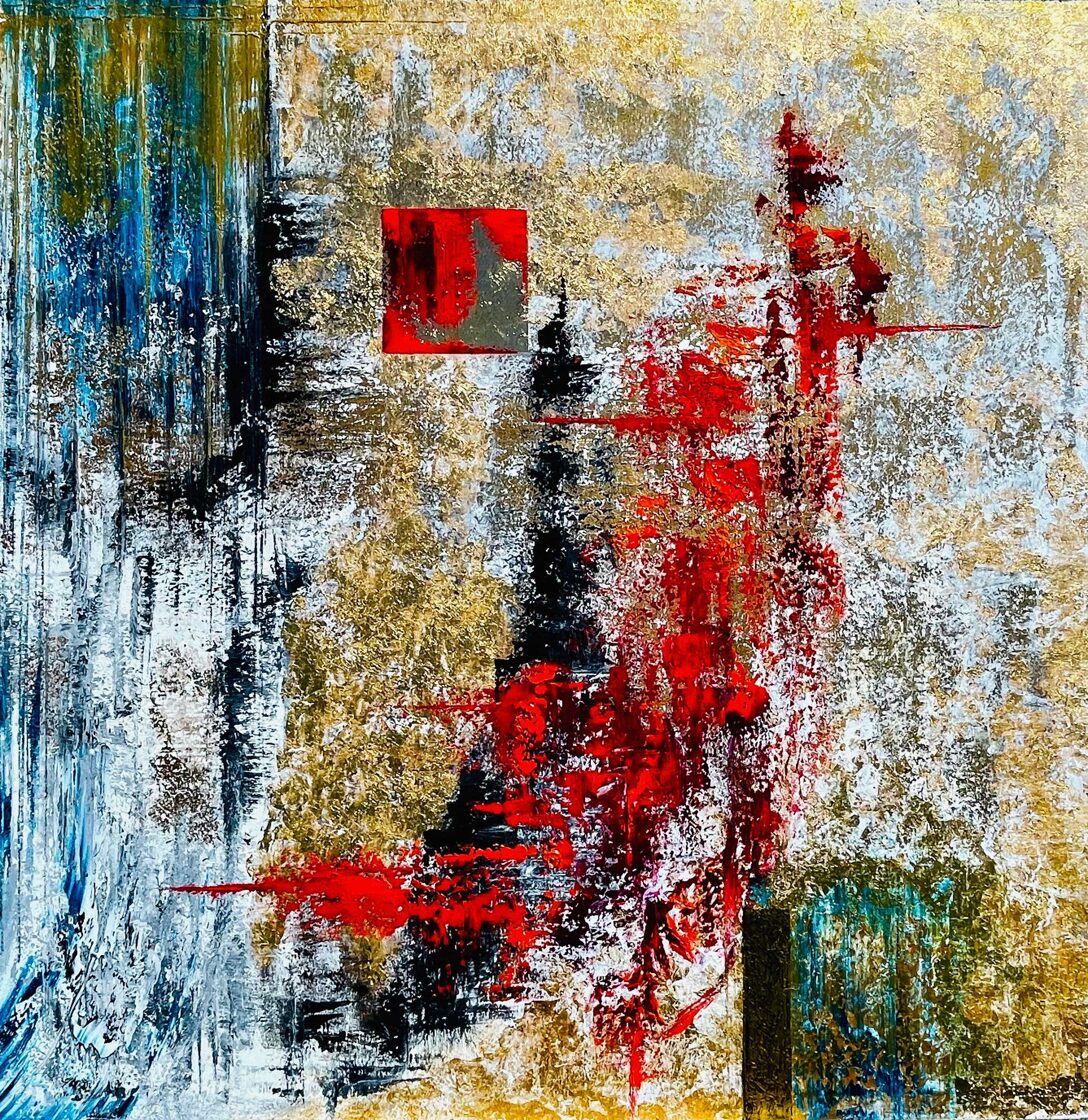
It is safe to say that if Isabella had not kept her secret promise and Ferdinand had not been her husband, nothing of what we have come to know as the world, as planet Earth, would exist today. It was one of the most important marriages in history, or perhaps arguably one of the most life-changing. Where the sun shines, there are of course shadows as well. But the creation continued: Charles V further increased the splendour of the Hispanic Empire.
III.
Las Infantas / The Imfantas
Rondo-El matrimonio de Johanna / Rondo-Johanna's marriage
140x140 óleo / oil, oro / gold, lienzo / canvas, 2024 Sitges/Barcelona
VENDIDO/SOLD
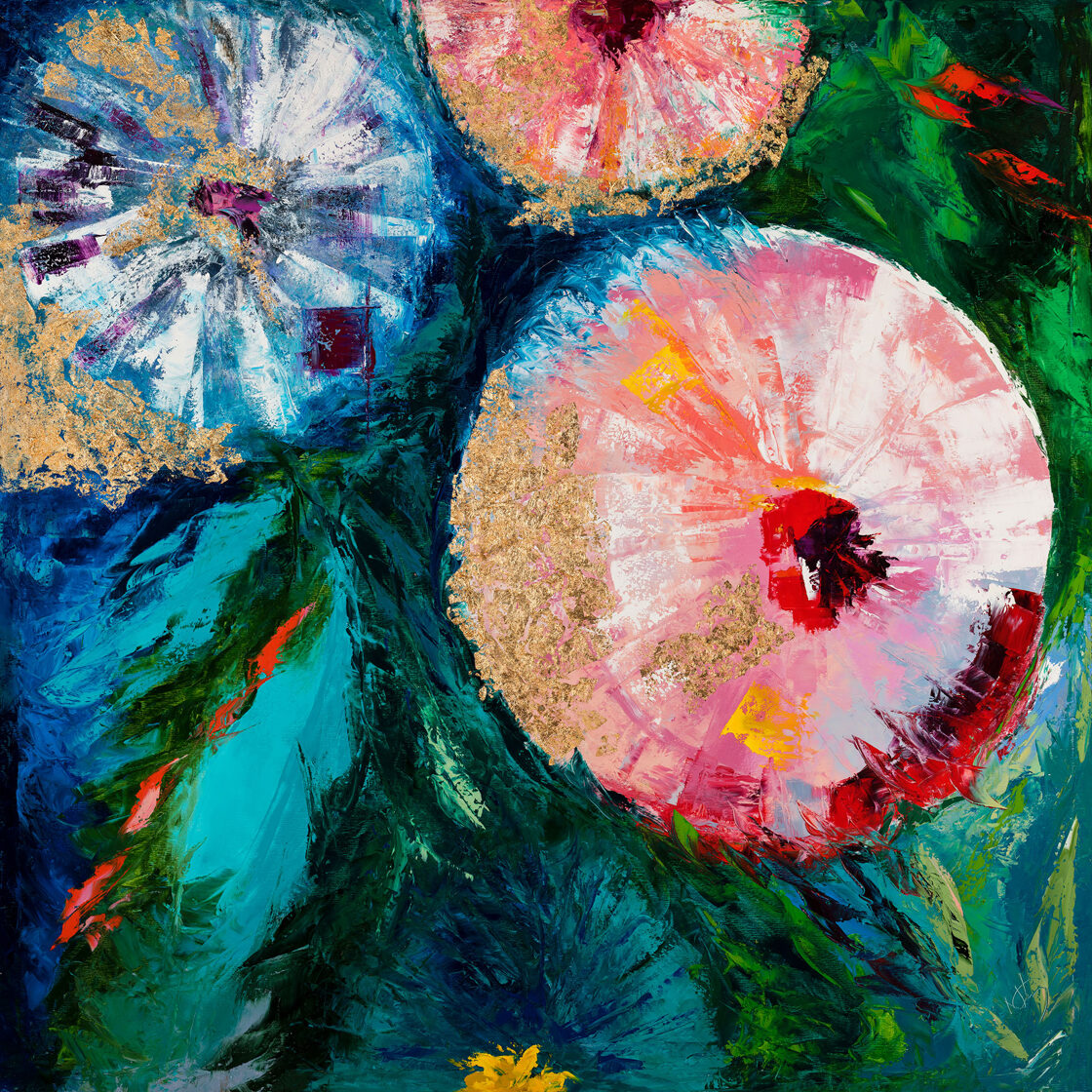
En Agosto de 1496, Juana de Castilla y Aragón, de dieciséis años, zarpó del puerto de Laredo para llegar a las tierras bajas alemanas. El propósito de la visita era conocer a su futuro esposo, el príncipe Felipe de Borgoña, hijo del emperador germano-romano Miguel. El matrimonio se acordó para unir la Casa de Trastámara y la dinastía de los Habsburgo. Juana la Loca y Felipe el Hermoso se enamoraron en su primer encuentro y en pocas horas se encendió la pasión entre ellos. Según los cronistas, la Infanta y el Príncipe no podían esperar a la boda. Finalmente, la bella Juana la Loca se presenta ante el altar con un vestido rosa con interior carmesí...
In August 1496, sixteen-year-old Juana of Castile and Aragon set sail from the port of Laredo for the German lowlands. The purpose of the visit was to meet her future husband, Prince Philip of Burgundy, son of the German-Roman Emperor Michael. The marriage was arranged to unite the House of Trastamara and the Habsburg dynasty. Juana and Philip the Handsome fell in love at their first meeting and within a few hours passion was ignited between them. According to chroniclers, the Infanta and the Prince could not wait for the wedding. Finally, the beautiful Juana appears at the altar in a pink dress with crimson lining...
El peculiar matrimonio / The peculiar marriage
100x100 óleo / oil, oro / gold, lienzo / canvas, 2024 Sitges/Barcelona
VENDIDO/SOLD
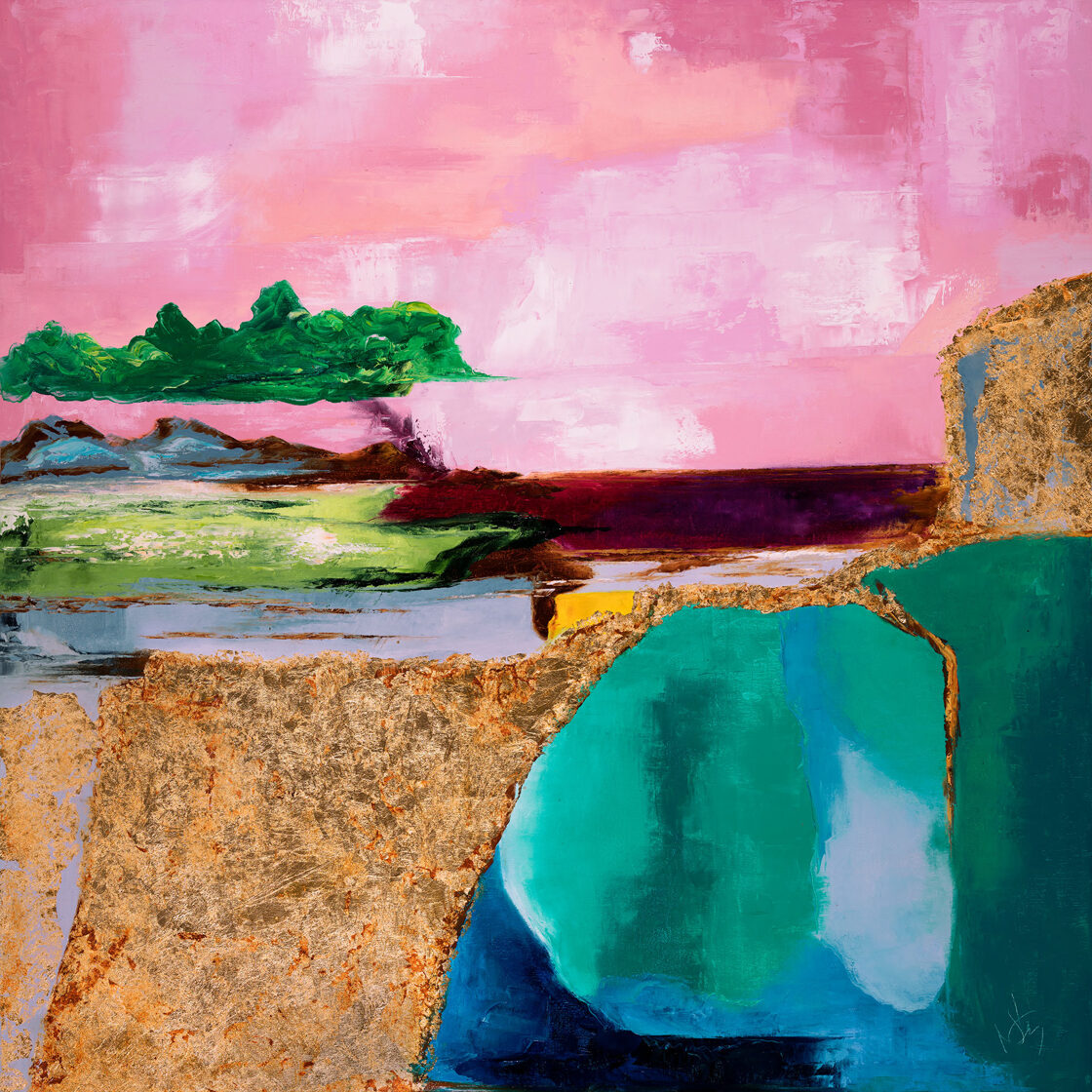
Margarita Teresa de Austria sólo tenía 15 años cuando se casó con el emperador austriaco Leopoldo I. Se trataba de una decisión arriesgada, ya que si sus padres no producían un heredero al trono, el trono español pasaría a Austria por matrimonio a su muerte. Aunque Leopoldo era mucho mayor que su esposa y su aspecto físico se consideraba desfavorable, la crónica describe su matrimonio como feliz: ambos eran aficionados a la naturaleza, la música y amaban las fuentes y los lagos de baño. Tuvieron dos hijos. La Emperatriz dice que, desde que conoció a Leopoldo I, camina sobre las nubes. Sin embargo, en el cuarto parto, murió con el niño. El Emperador la enterró en un ataúd de oro y él no volvió a casarse.
Margaret Theresa of Austria was only 15 years old when she married the Austrian Emperor Leopold I. It was a risky decision becasue if her parents failed to have an heir to the throne, the Spanish throne would pass to Austria by her marriage upon their death. Although Leopold was much older than his wife and his physical appearance was considered unfavourable, the chronicle describes their marriage as a happy one: both were fond of nature, music and loved fountains and bathing lakes. They had two children. According to the Empress, ever since she met Leopold I, she has been walking on clouds. However, during her third childbirth, she died with her child. The Emperor buried her in a golden coffin and he never ever married again.
La boda / The wedding
120x100 óleo / oil, oro / gold, lienzo / canvas, 2024 Sitges/Barcelona
VENDIDO/SOLD
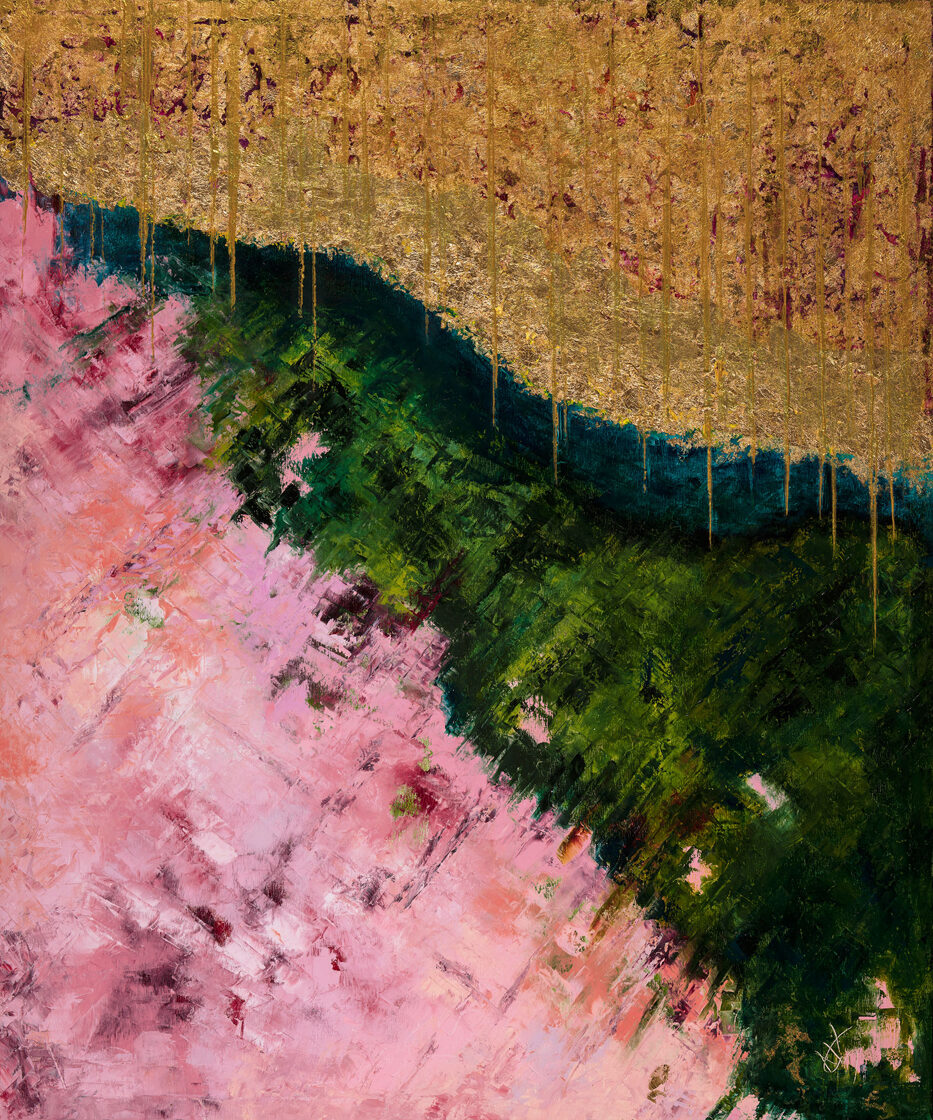
María Teresa Antonia Rafaella era una mujer madura cuando se casó, pero su marido Fernando Luis, de sólo 16 años, no estaba preparado para el matrimonio. El joven fue objeto de comentarios irónicos por parte de la corte francesa. Se rumoreaba que Fernando era impotente. La sensible princesa se retiró y pasó la mayor parte del tiempo alejada de la vida cortesana. Dos años más tarde, sin embargo, lograron reunirse y casarse, poniendo fin a las malvadas bromas de la corte. La relación sentimental de la pareja se reavivó y pasaron mucho tiempo juntos. Los esposos demostraron abiertamente el gran afecto que sentían el uno por el otro.
Maria Theresa Antonia Rafaella was a mature woman when she got married, but her husband Ferdinand Louis, only 16 years old, was clearly not ready for marriage. The young man was the subject of ironic comments from the French court. Ferdinand was rumoured to be impotent. The sensitive princess withdrew and spent most of her time away from court life. Two years later, however, they were reunited and contiued their marriage, putting an end to the wicked court jokes. The couple's romantic relationship was rekindled and they spent a lot of time together. The couple openly demonstrated their great affection for each other.
El apaciguamiento / The appeasement
100x100 óleo / oil, oro / gold, lienzo / canvas, 2024 Sitges/Barcelona
VENDIDO/SOLD
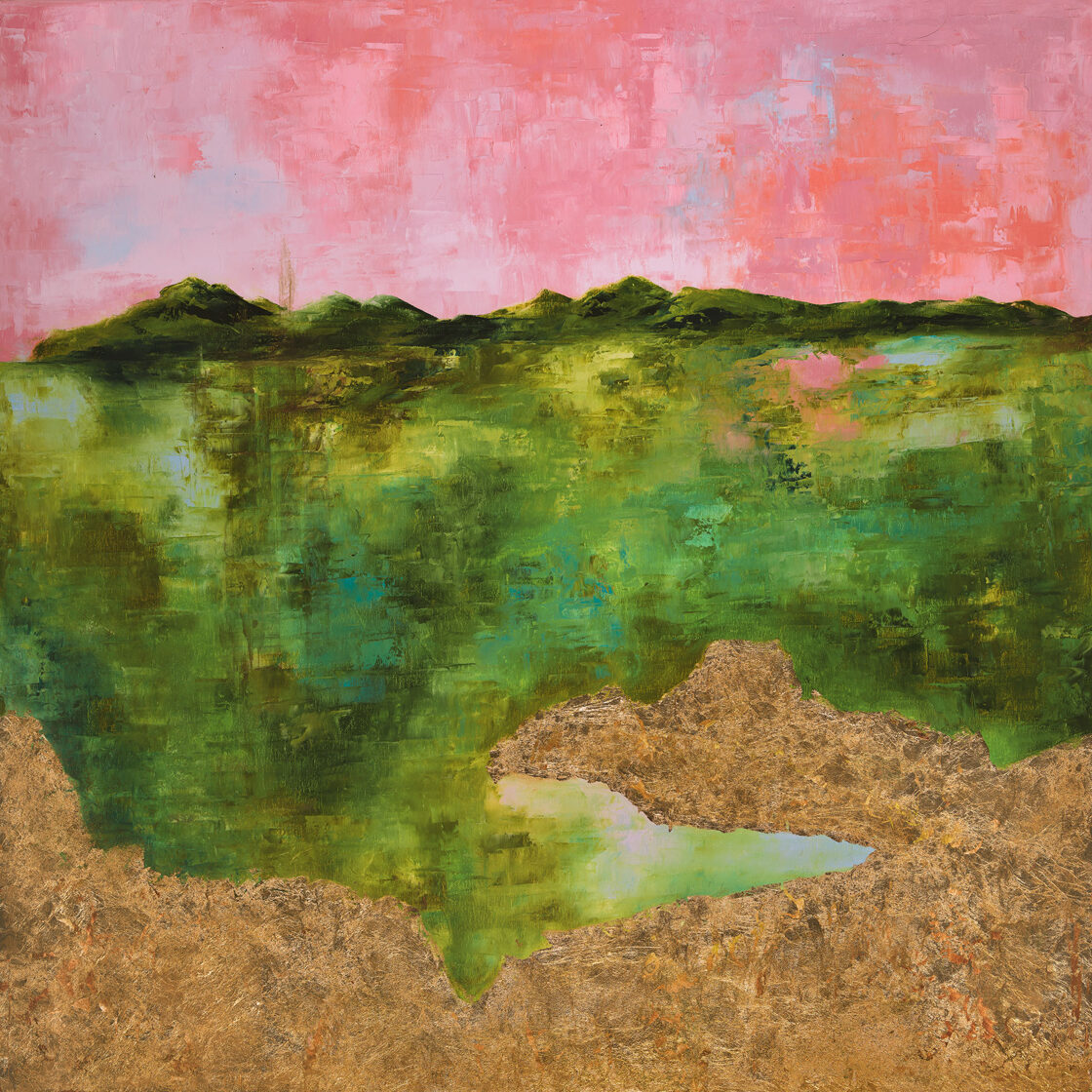
La obra narra el reinado de la infanta Isabel Clara Eugenia y el archiduque Alberto VII de Austria, considerado la edad de oro de los Países Bajos hispanos. Tras cuatro décadas de guerra, la paz y la estabilidad volvieron a la zona y la pareja hizo todo lo posible por ayudar a restaurar la economía y la sociedad. También se puso fin a la persecución religiosa y los protestantes dejaron de ser amenazados y se les permitió practicar su religión libremente. Se les atribuye la difusión del estilo barroco flamenco, y los encargos a Rubens y Van Dyck son constantes, pero entre sus mecenas figuran Brueghel y Van Veen.
The work recounts the reign of the Infanta Elisabeth Clara Eugenie and Archduke Albert VII of Austria, considered the golden age of the Hispanic Netherlands. After four decades of war, peace and stability returned to the area and the couple did all they could to help restore the economy and society. Religious persecution was also ended and although Protestants were allowed to practice their religion freely, they were no longer threatened and . They are credited with spreading the Flemish Baroque style, and commissions for Rubens and Van Dyck are constant, but their patrons included Brueghel and Van Veen.
El Jardín de Jozefa / The garden of Jozefa
100x100 óleo / oil, oro / gold, lienzo / canvas, 2024 Sitges/Barcelona
VENDIDO/SOLD
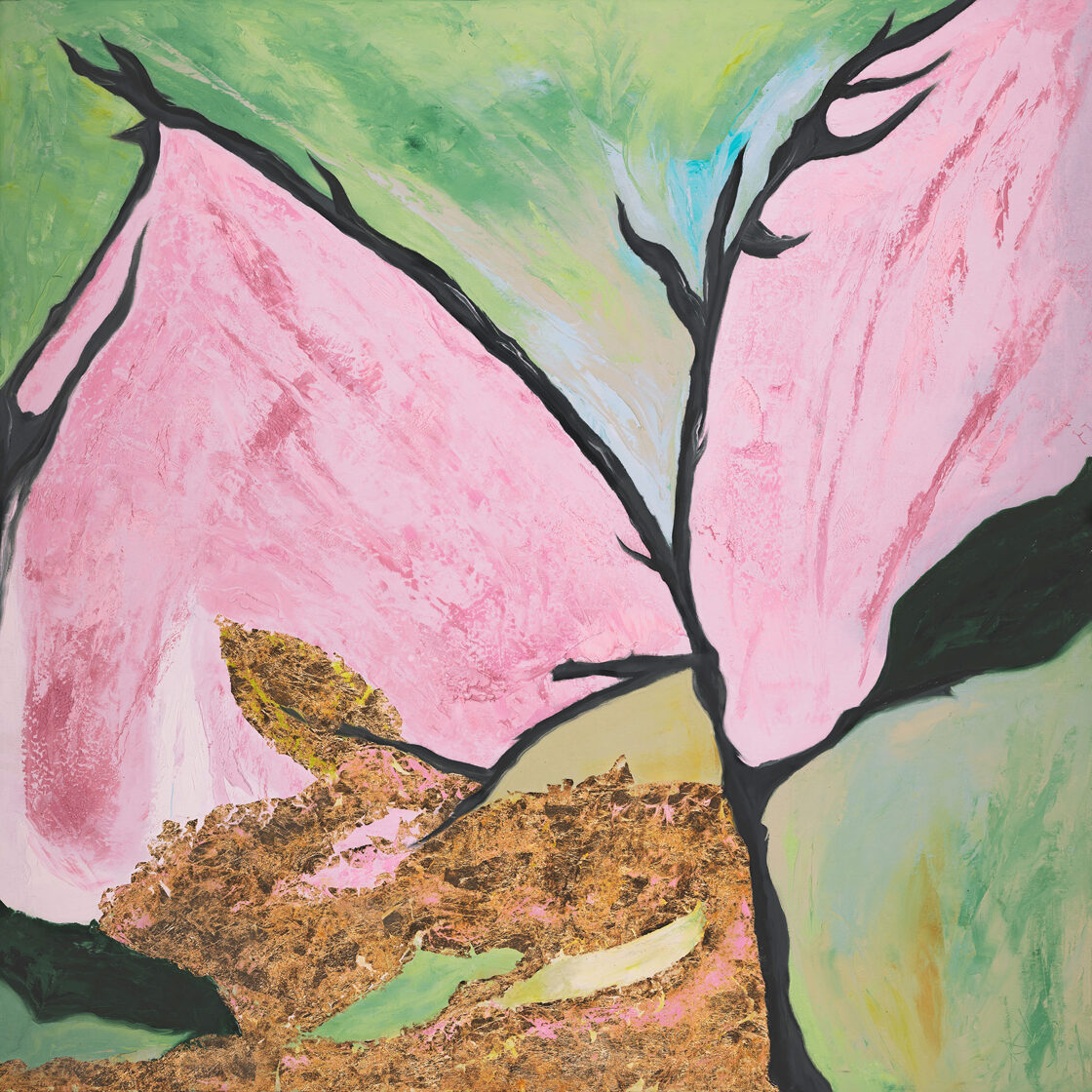
El cuadro cuenta la historia de dos corazones. La infanta Josefa Fernanda de Borbón se casó en secreto con el escritor y político José Güell Renté en un matrimonio sin amor. El romance la llevó a ser despojada de su título de princesa por la Reina y desterrada de la corte. Josefina y su marido vivieron recluidos en una pequeña finca con sus hijos, cuyo jardín, según la leyenda, era una fuente constante de magnolias en flor.
The painting tells the story of two hearts. The Infanta Josefa Fernanda de Borbón secretly married the writer and politician José Güell Renté in a loveless marriage. The affair led to her being stripped of her title of princess by the Queen and banished from the court. Josefina and her husband lived in seclusion on a small estate with their children, whose garden, according to legend, was a constant source of magnolias in bloom.
El Jardín de Jozefa - estudio / Garden of Jozefa - study
72x52 óleo / oil, oro / gold, lienzo / canvas, 2024 Sitges/Barcelona
VENDIDO/SOLD
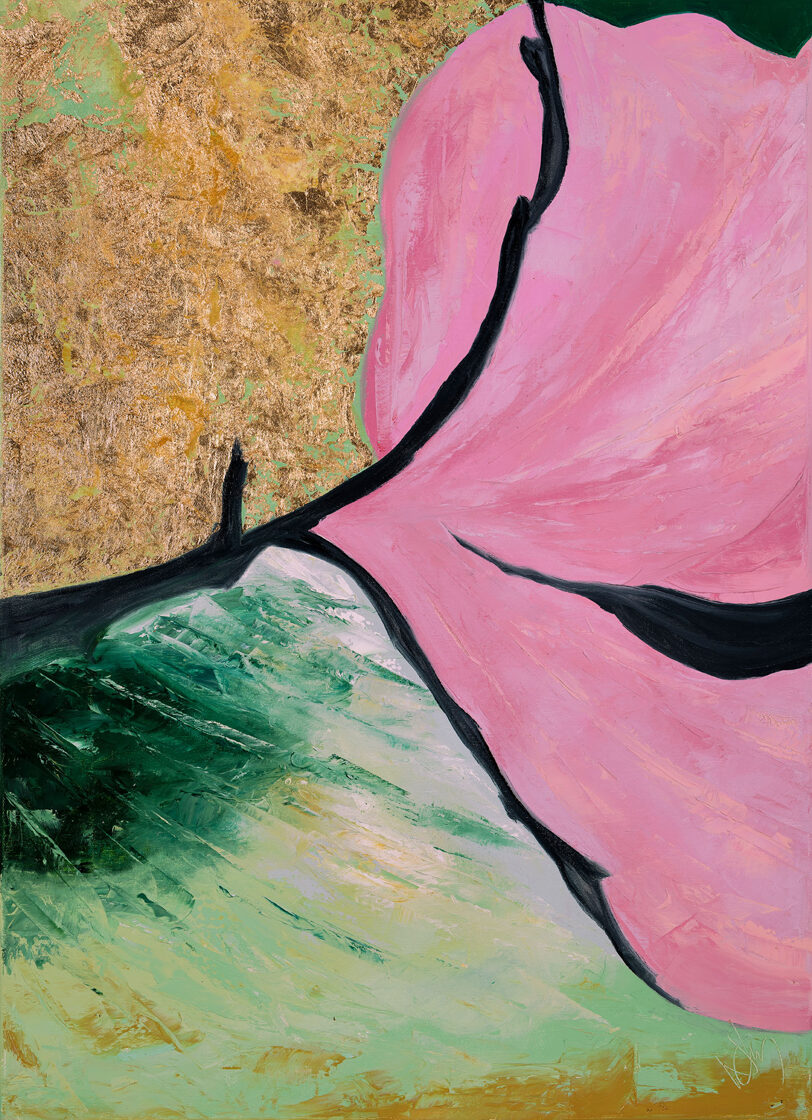
El Jardín de Josefa - un estudio para el capítulo de Hispania - el ciclo de las estaciones de la Corona Las Infantas.
Josefa's Garden - a study for the Hispania - the cycle of the centuries of the Corona, Las Infantas' chapter.IV.
Hispania romana
Doscientos años / 200 years
120x120 óleo / oil, oro / gold, lienzo / canvas, 2024 Sitges/Barcelona
VENDIDO/SOLD
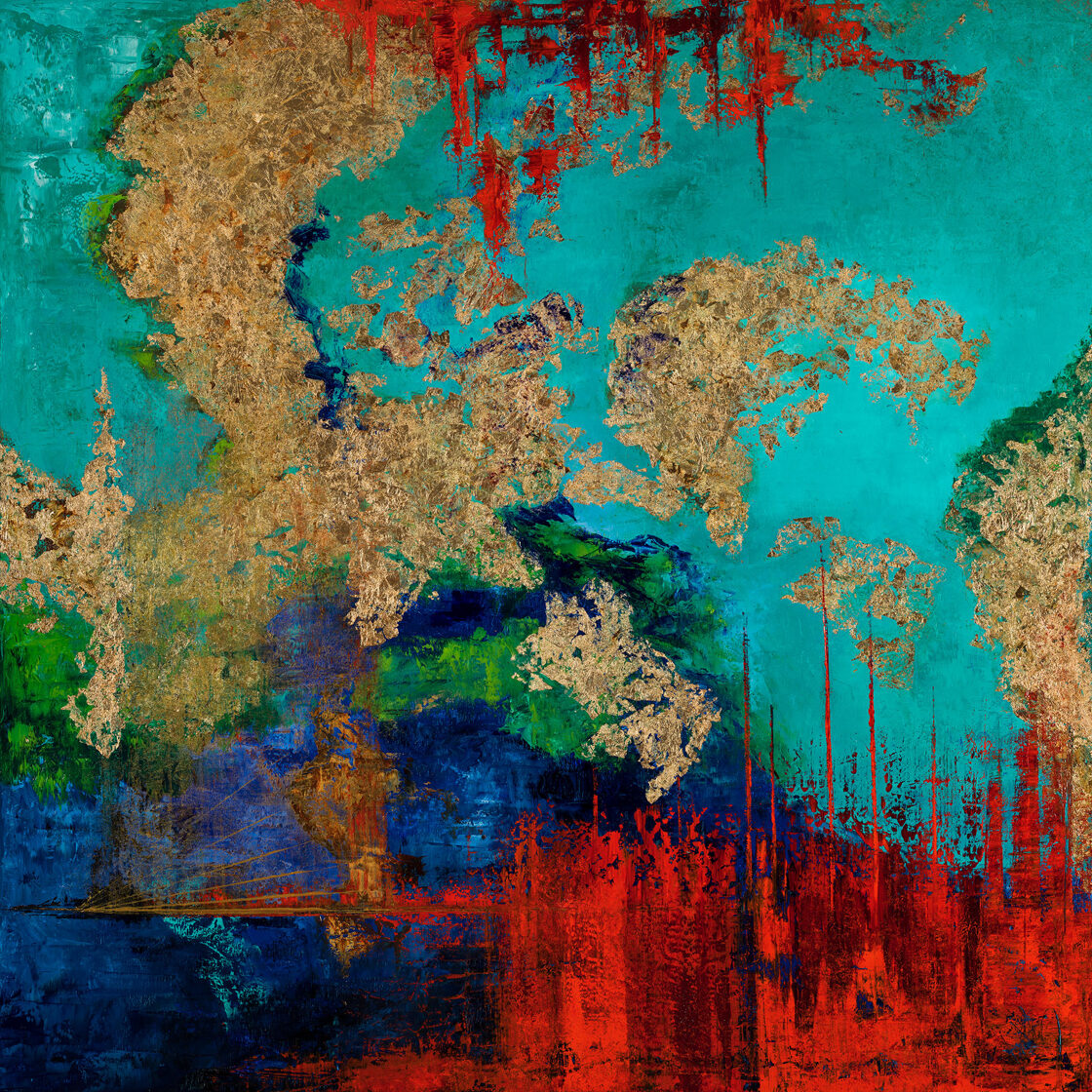
El vasto territorio de la península ibérica fue conquistado por los romanos -en comparación con la rapidez con que lo hicieron en otras zonas de su imperio- de forma bastante lenta, en 200 años para ser exactos: pisaron Emporion (Ampurias) en el 218 a. C., y el Emperador Augusto puso fin a la Guerra Cántabra en el 19 a.C. Livio lo recoge cum grano salis:
"Hispania fue la primera donde los romanos vinieron a conquistar, y la última que conquistaron" (XXVIII. 12.12).
The vast territory of the Iberian Peninsula was conquered by the Romans - compared to the speed with which they conquered other parts of their empire - rather slowly, in 200 years to be exact: they set foot in Emporion (Ampurias) in 218 BC, and Emperor Augustus put an end to the Cantabrian War in 19 BC. Livius records it cum grano salis (with a "pinch of salt"):
"Hispania was the first where the Romans came to conquer, and the last they conquered" (XXVIII. 12.12).
El Imperio del Fuego / The Empire of Fire
80x220 óleo / oil, oro / gold, lienzo / canvas, 2024 Sitges/Barcelona
VENDIDO/SOLD
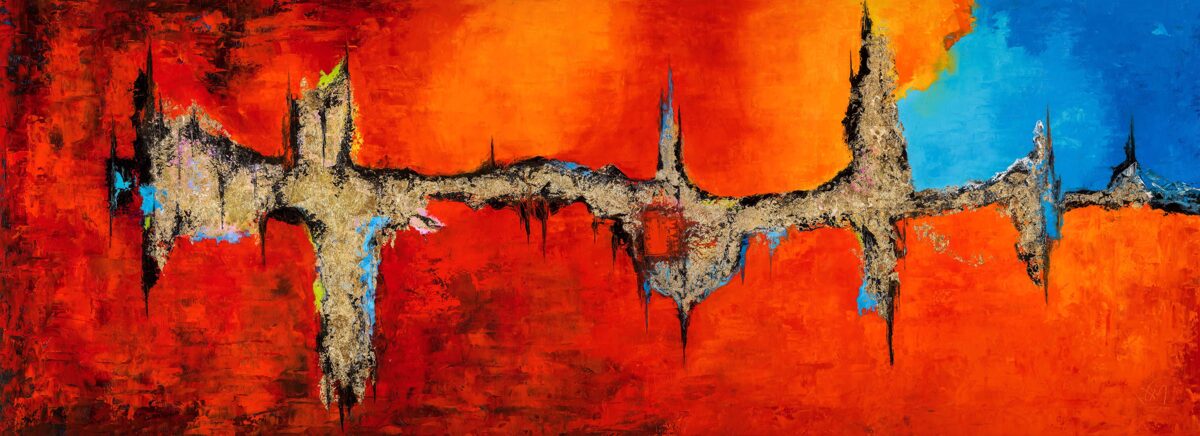
La provincia de Hispania no solo era importante y noble para los romanos por razones económicas. Creían que la península era un reino de llama y fuego, donde nacían los destinados a grandes cosas. Aquí nacieron Trajano, Adriano y Teosodio I, pero también fue la cuna de Séneca, Martialis y Qiuntianus.
The province of Hispania was not only considered important and noble to the Romans for economic reasons. They believed that the peninsula was a kingdom of flame and fire, where those destined for great things were born. Trajan, Hadrian and Theosodius I were all born here, but it was also the birthplace of Seneca, Martialis and Qiuntianus.Betis
150x50 óleo / oil, oro / gold, lienzo / canvas, 2024 Sitges/Barcelona
VENDIDO/SOLD

El Betis, ahora conocido como río Guadalquivir, cuyas crecidas crearon un fértil valle donde el cultivo del olivo y la vid eran importantes en la antigüedad, era el alma de la provincia. El río era fácilmente navegable en barco hasta la ciudad de Hispalis (Sevilla), que era el centro de la región. La importancia del río se veía reforzada por el hecho de que se utilizaba para transportar los ricos recursos minerales de Sierra Nevada hasta el puerto de Gades (Cádiz) y desde allí a otras partes del Imperio Romano.
The Betis, now known as the Guadalquivir River, whose floods created a fertile valley where the cultivation of olives and wineries was important in ancient times, was the lifeblood of the province. The river was easily navigable by boat to the city of Hispalis (Seville), which was the centre of the region. The river's importance was reinforced by the fact that it was used to transport the rich mineral resources of the Sierra Nevada to the port of Gades (Cadiz) and from there to other parts of the Roman Empire.
Nomen est Omen
80x80 óleo / oil, oro / gold, lienzo / canvas, 2024 Sitges/Barcelona
VENDIDO/SOLD
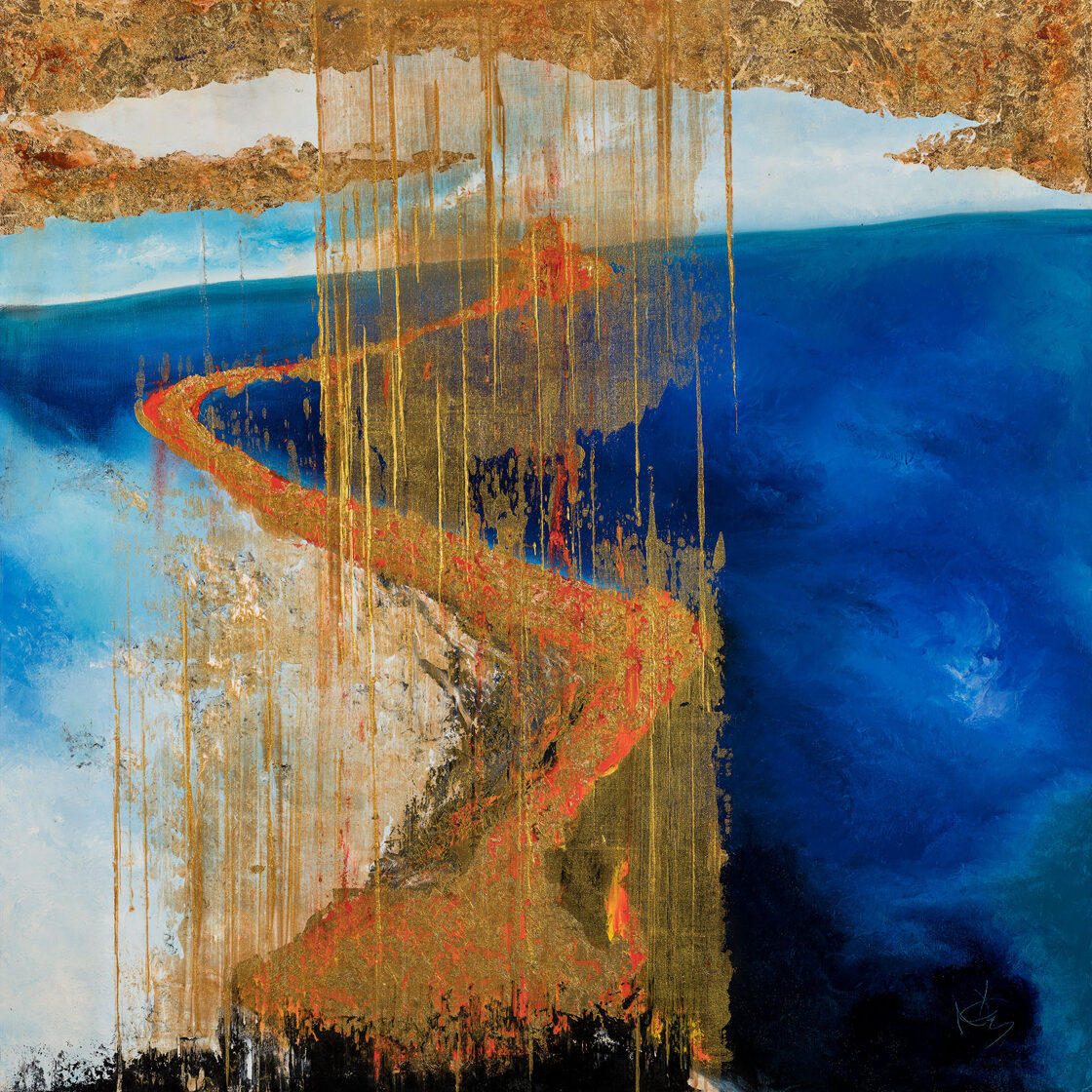
La floreciente Nueva Cartago, que también destacó entre las ciudades de las provincias del imperio y perduró hasta mediados del siglo VI d. C., corrió una terrible suerte, rivalizando con Roma en prosperidad: los árabes incendiaron la ciudad y la destruyeron en 647.
The flourishing New Carthage, which also stood out among the cities of the empire's provinces and lasted until the mid-7th century AD, met a terrible fate, rivalling Rome in prosperity: the Arabs burned the city and destroyed it in 647.Las Médulas
120x100 óleo / oil, oro / gold, lienzo / canvas, 2024 Sitges/Barcelona
VENDIDO/SOLD
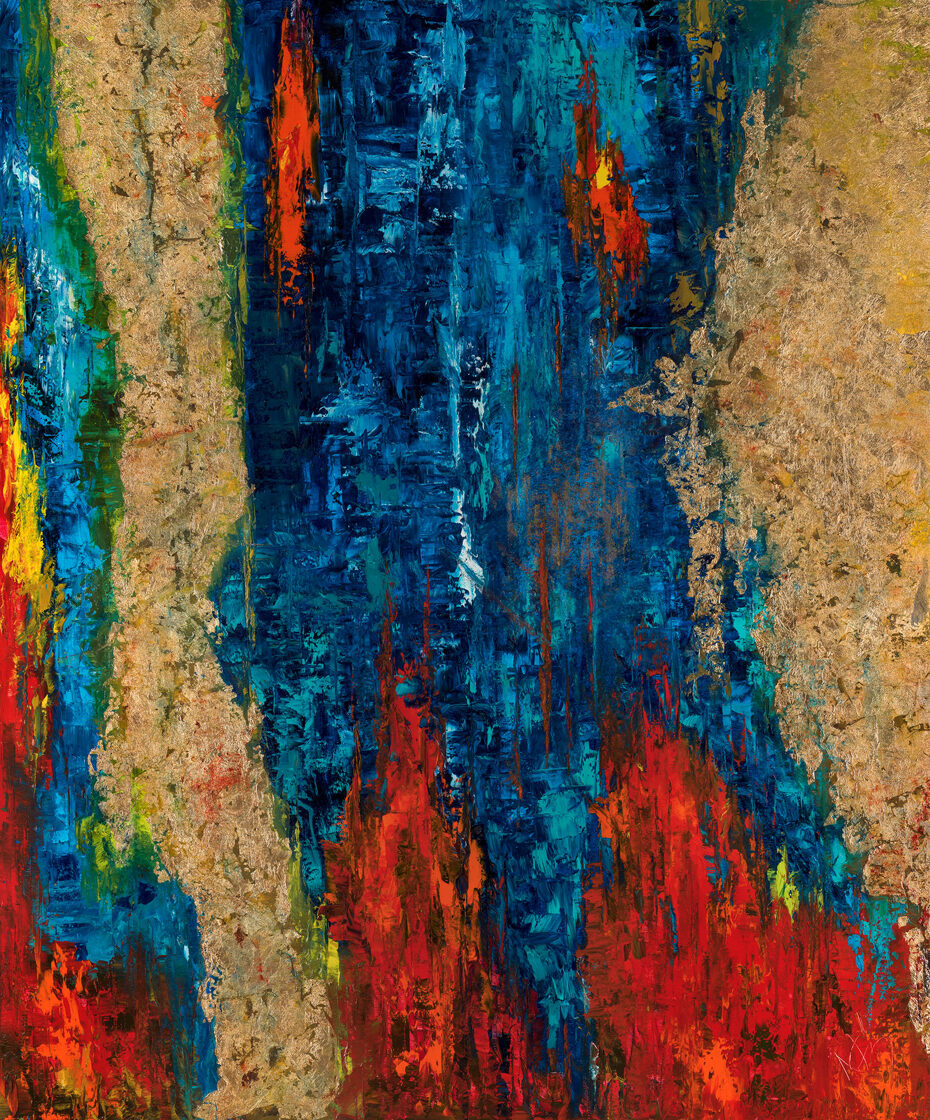
En su día fue la mina de oro más importante del Imperio Romano y se explotó durante doscientos años desde el siglo I a. C. La ruina montium, un método minero romano, creó un paisaje de belleza incomparable. Se excavaban túneles en las colinas y luego se inundaban con grandes cantidades de agua. Esto provocaba literalmente el derrumbamiento de la cima de la montaña. Las grandes cantidades de agua necesarias para la operación se traían hasta aquí desde la Sierra de la Cabera a través de un canal de 100 kilómetros de longitud.
It was once the most important gold mine in the Roman Empire and was exploited for two hundred years from the 1st century B.C. The ruina montium, a Roman mining method, created a landscape of incomparable beauty. Tunnels were dug into the mountains and then flooded with large quantities of water. This literally caused the top of the mountain to collapse. The large quantities of water needed for the operation were brought there from the Sierra de la Cabera via a 100-kilometre-long canal.
El día / The day
96x146 óleo / oil, oro / gold, lienzo / canvas, 2024 Sitges/Barcelona
VENDIDO/SOLD
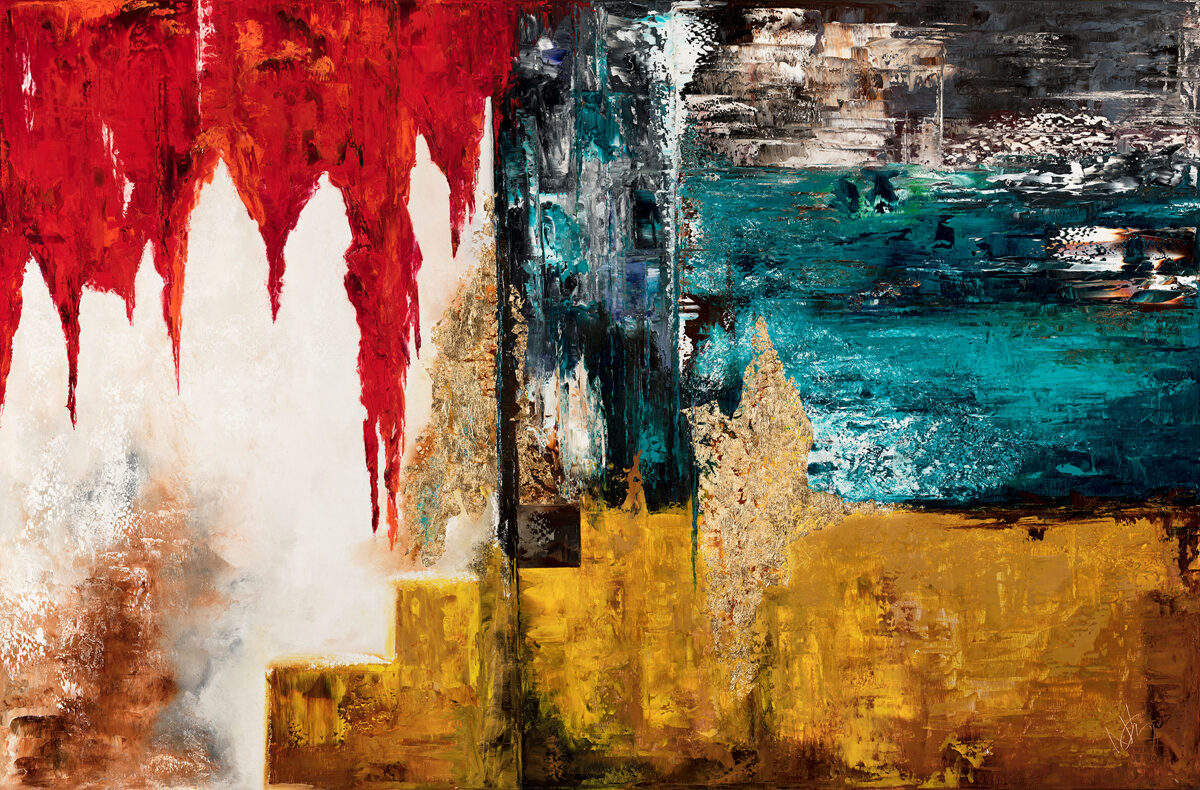
El territorio de los nazaríes musulmanes, con Granada como centro, se extendía hasta las estribaciones de Sierra Nevada. Aprovecharon la caída de los almohades para hacerse con el poder, pero su dominio no duró mucho. Mohamed XII fue incapaz de rechazar el ataque de las fuerzas aliadas de Castilla y Aragón, que habían florecido bajo Isabel I y Fernando II, y el 2 de enero de 1492 rindió la Granada sitiada, creando así un reino unificado y católico.
The territory of the Muslim Nasrids, with Granada at its centre, stretched as far as the foothills of the Sierra Nevada. They took their advantage of the fall of the Almohads to seize power, but their rule did not last long. Mohammed XII was unable to repel the onslaught of the allied forces of Castile and Aragon, which had flourished under Isabella I and Ferdinand II, and on 2 January 1492 he surrendered the besieged Granada, resulting in a unified, Catholic kingdom.
V.
El imperio donde nunca se pone el sol / The empire where the sun never sets
La Oferta / The Offer
150x100 óleo / oil, oro / gold, lienzo / canvas, 2024 Sitges/Barcelona
VENDIDO/SOLD
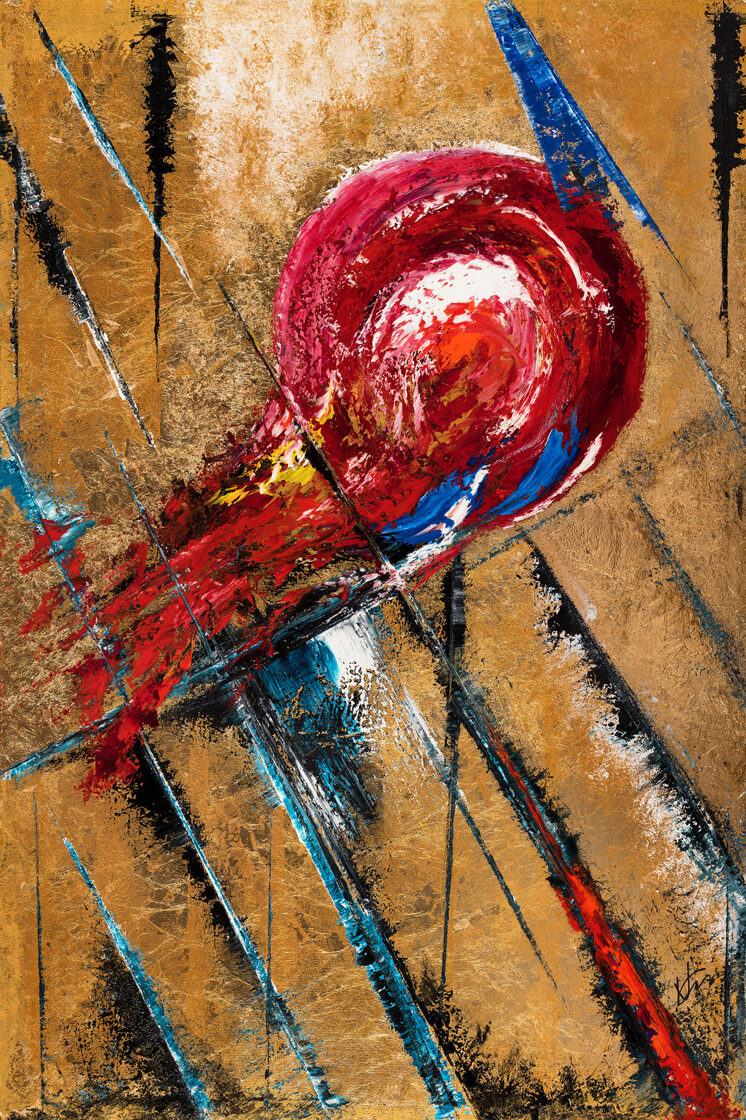
En 1492, España expulsó al último gobernante musulmán de Granada. Tras su victoria, los gobernantes católicos se pusieron en contacto con Cristóbal Colón, un marino genovés que intentaba llegar a Japón en barco. Castilla competía desde hacía tiempo con Portugal por llegar a Extremo Oriente por mar, así que cuando Colón hizo su audaz oferta a la reina Isabel de Castilla, la corte le prometió su apoyo sin dudarlo. Entonces Colón descubrió "accidentalmente" lo que vino a denominarse América, en vez de Extremo Oriente, y cambió el mundo y su historia.
In 1492, Spain expelled the last Muslim ruler of Granada. After their victory, the Catholic rulers got in contact with Christopher Columbus, a Genoese sailor who was trying to reach Japan by ship. Castile had long been in competition with Portugal to reach the Far East by sea, so when Columbus made his bold offer to Queen Isabella of Castile, the court pledged its support without hesitation. Columbus then "accidentally" discovered what came to be called America, rather than the Far East, and changed the world and its history.
El Tratado / The Treaty
100x100 óleo / oil, oro / gold, lienzo / canvas, 2024 Sitges/Barcelona
VENDIDO/SOLD
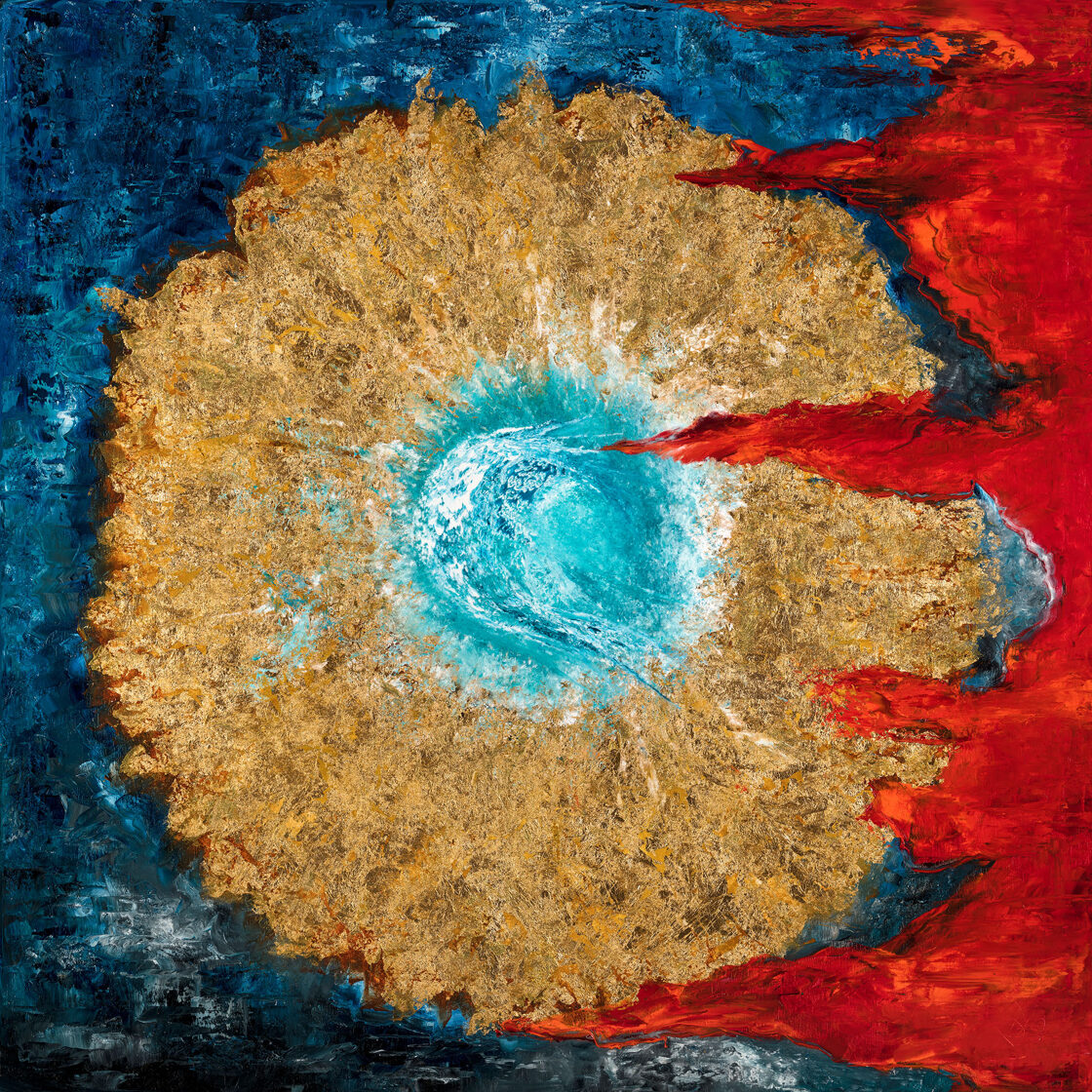
El Tratado de Tordesillas, firmado en 1494 en Tordesillas, España, que dividió los territorios recién descubiertos fuera de Europa entre España y Portugal. El tratado, que excluía a las demás potencias europeas de la exploración, fue ratificado por el Papa Alejandro VI.
The Treaty of Tordesillas, signed in 1494 in Tordesillas, Spain, divided the newly discovered territories outside Europe between Spain and Portugal. The treaty, which excluded all other European powers from the exploration, was ratified also by Pope Alexander VI.
Orígenes - De Altamira a los Borbones / Origins - From Altamira to the Bourbons
100x100 óleo / oil, oro / gold, lienzo / canvas, 2024 Sitges/Barcelona
VENDIDO/SOLD

La historia de la Península Ibérica se remonta a 1,4 millones de años. Tras los íberos, turdetanos y celtas, los romanos, luego los visigodos, árabes y bereberes se repartieron el singular territorio, hasta que Castilla y Aragón entraron en unión personal a finales del siglo XV. Tras la extinción de la rama hispana de la dinastía de los Habsburgo, la dinastía francesa de los Borbones proporcionó los reyes del imperio. Desde las pinturas murales de la cueva de Altamira, de 17.000 años de antigüedad, pasando por la colonia griega de Empúries y el trágico Guernica, hasta el siglo XXI, se trazó el camino hacia el último bastión de la libertad, la España actual.
The history of the Iberian Peninsula goes back 1.4 million years. After the Iberians, Turdetans and Celts, the Romans, the Visigoths, the Arabs and then the Berbers divided up the unique territory up until Castile and Aragon entered into a personal union at the end of the 15th century. After the extinction of the Hispanic branch of the Habsburg dynasty, the French Bourbon dynasty provided the kings of the empire. From the 17,000-year-old wall paintings in the cave of Altamira, through the Greek colony of Empúries and the tragic Guernica, this lasting journey til the 21st century created the last bastion of freedom, i.e. today's Spain.
La época dorada / The golden era
140x140 óleo / oil, oro / gold, lienzo / canvas, 2024 Sitges/Barcelona
VENDIDO/SOLD
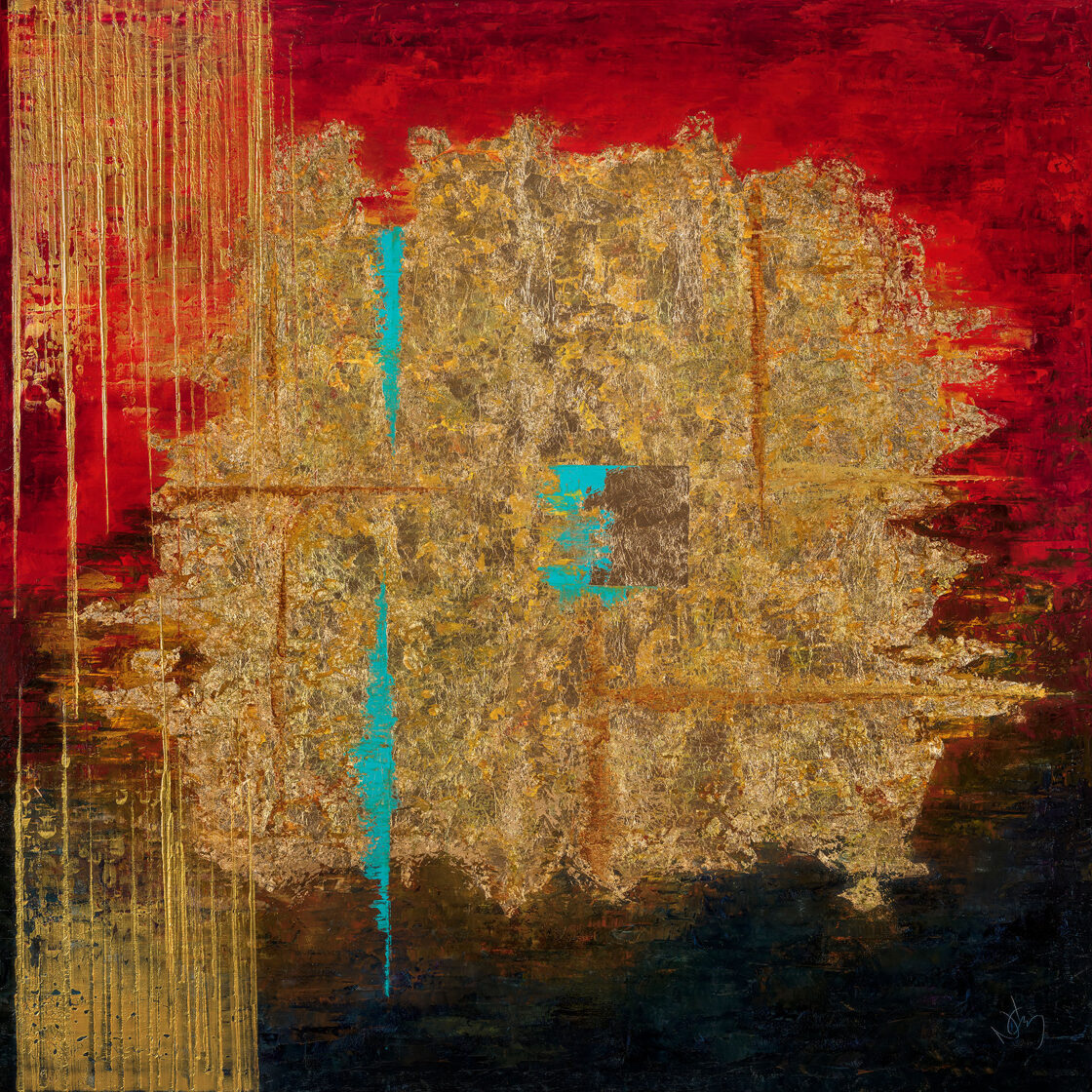
La gloria de la corona hispánica alcanzó su apogeo en el reinado de Carlos V, el monarca más poderoso del mundo, que ejercía su poder desde Sevilla y no desde Madrid. Las historias de las ciudades de oro no eran sólo leyendas, al igual que era cierto que el reino hispano poseía las mayores reservas de plata del mundo. El imperio duró más de cinco siglos y cambió no sólo la historia del mundo, sino también la cultura, la lengua, la religión y la demografía de los territorios que gobernaba.
The glory of the Hispanic crown reached its peak in the reign of Charles V who was considered then the most powerful monarch in the world and who wielded his power from Seville rather than Madrid. The stories of the golden cities were not just legends, just as it was true that the Hispanic kingdom possessed the largest reserves of silver in the world. The empire lasted more than five centuries and changed not only the history of the world, but also the culture, language, religion and the demography of the territories it ruled.
Cart
Cart is empty.




























































































































